Don't wanna be here? Send us removal request.
Text
Theme through Exposition (Matrix Reloaded, Revolutions & Resurrections)
This is part 2 of a series looking at the Matrix films. You can read the first part before continuing.
Which brings us to the sequels, Reloaded, and Revolutions. These were made at the same time, and function as two halves of the same story. So I'll look at them as one block. Though in less detail... And I've tagged on a bit about Resurrections at the end to round out the series.
youtube
First, the reviews:
I enjoyed Reloaded and Revolutions a fair bit less than the first film. Of course, there wasn't that gut-punch of a brand new concept to my psyche--that's to be expected. But something about it was qualitatively different to me.
Compared to the small-scale, big-concept of The Matrix... these sequels were all about the big-scale, high-concept. Giant fights (utilising a lot of pure-CGI), in giant places (the dock, and the entire Matrix). While the concepts are less "big," more just... "high."
There was always some philosophy stuff floating around in the Matrix, but the focus was on the Matrix as a concept--rather than discussions on the definition of a word and the abstract impact that definition has on existence itself. Which basically stops the momentum of the story because really nothing is happening.
The bigger scale of the battles and fights is fine by itself. There's a lot of fun sequences in there. But compared to the tighter story-driven fight scenes in the first film, it often felt a bit "and now there's going to be a fight/battle scene." It was easy to get lost regarding why the heroes were doing what they were doing, and what their goal was.
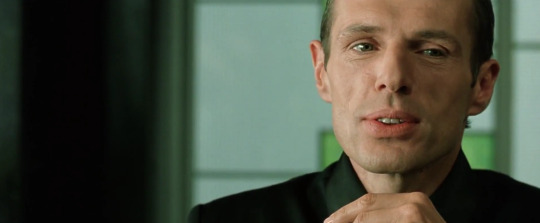
Why is Neo fighting all those Agents if he can just fly away? Why do they need the Key Maker? Where are they trying to get to? What's the stakes?
Interestingly, the film actually comments on that. With the Merovingian telling the heroes they don't know why they are doing things. And the Oracle telling Neo his job isn't to make a choice, but to understand the future choice he's already made. (More on that later.)
Which... okay, that could happen in a story I guess--characters doing what they can but not really knowing what to do. But it means the viewer doesn't understand the motivation of the characters, because the characters don't understand their own motivations... which in turn means it's easy to just not really care about what's going on.
And then the more recent Resurrections. Which, to sum up, is a mess.
youtube
Half Matrix-inspired saturday morning cartoon with a load of colourful one-dimensional characters that do almost nothing (reminded me a lot of some of the Transformers movies in that way). And half meta commentary on the circumstances of making the film, what they thought about the Matrix series and about the suits at Warner Brothers who demanded it be made.
I'm not going to go down the rabbit-hole of the meta stuff about production in this article. You can look into that stuff elsewhere. But watching it with this stuff in mind, and it being so obvious in the subtext (and text) of the movie... it felt like I was watching a mental breakdown as expressed through the medium of film.
But anyway... theme!
The theme of M2 & M3 is Choice... but instead of how "Belief is choice," it's about how "Purpose is choice."
This concept is explored primarily through conversations.
The Oracle tells Neo, "You're not here to make a choice. You're here to understand why you made the choice." [M2 0:45:40] So yes, fate and predestination is real, there is no such thing as real choice. Purpose is a choice already made. Neo should focus on figuring out what his purpose is, not about making free choices.
Which goes against the whole concept of "free your mind" and Neo's free choices being the crux of the whole thing, of being the One in the first place.
Without a lot of work on the viewer's part to untangle the philosophy of it all, it feels very incongruous to the reason they are watching this film... because the loved the first film.
The Merovingian says it is the "why" that has the power. And the gang does not know why they are doing any of this. They are choosing to do what they're told, without understanding why they are choosing to do it. [M2 1:05:22]
Which is totally true. The Oracle said "jump," and they said "how high?"
This is part of why it's not so enjoyable to watch. The viewer doesn't have any idea why they're doing what they're doing either; the characters have no motivation beyond "Oracle told me to do it." That's not an interesting motivation for a character to have.
When they have 3 ships and 3 missions, Morpheus says: "I do not see coincidence, I see providence. I see purpose." [M2 1:41:42]
Though in reality, one of those ships does nothing at all... beyond maybe making the others believe there's purpose and this is the right plan.
There's a lot of chat going on here, interleaved with carrying out the plan. The plan itself isn't that interesting. And we keep cutting back to Morpheus trying to make it all sound grander than it is. There's a lot of bouncing around in time, there's something about the timing of power dropping and when things blow up and when the door disappears and... it's all very confusing. Especially on first-viewing.
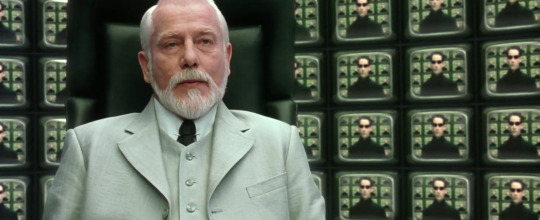
The Architect tells Neo why he exists in the first place, and therefore what his purpose is--why he chose to come here. To decide to let Zion die, make a new Zion with new people from the Matrix, and let the loop keep on looping. [M2 1:54:56]
This is actually quite a cool revelation, but is confusing as all get-out because it's written like an academic paper. It took me a fair bit of studying this scene to figure out what he was actually saying at any point in time.
And it actually turns out none of it was relevant because Neo just decides that's not his purpose, and takes the door no One before him ever took so he could save Trinity. ...Which also doesn't seem to affect anything but the decision in that moment.
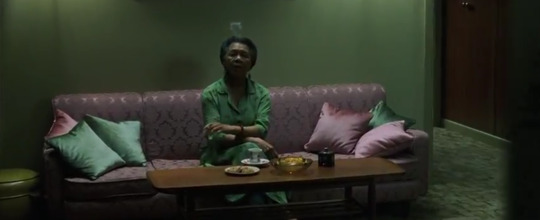
The Oracle has changed bodies, because she made a choice. "Since the test of any choice is to make it again, knowing full well what it might cost, I guess I feel pretty good about that choice. Because here I am, at it again." [M3 0:05:38]
This doesn't really fit in with the whole "purpose" idea. It's just more philosophical dialogue.
Morpheus has a crisis of faith, finding out that the prophecy was a lie. He asks the Oracle, "After everything that has happened, how can you expect me to believe you?" Who replies, "I don't. I expect just what I've always expected. For you to make up your own [darn] mind. Believe me or don't." [M3 0:07:00]
She told Neo this in the park, too. And it does fit with M1. Though all the other stuff she told Neo and everything the films are about goes against this idea So... it's just not very cohesive at all, and if you try to figure this stuff out, it comes out as pretty confusing just by itself.

Rama-Kandra speaks to Neo in the station. He's a program who controls recycling at the power plant. "It is my karma. A way of saying 'what I am here to do.' I do not resent my karma. I am grateful for it. Grateful for my wonderful wife, for my beautiful daughter." [M3 0:12:19]
But really his job had nothing to do with those things. He has a purpose. But also some amount of freedom to choose--to have relationships, to create new programs like Sati.
Though programs created for no real reason, like Sati, have no purpose. They exist purely to do whatever they feel like. To make choices. To use their free-will, you could say.
Though the Machines don't like anything to exist that has no purpose. It's just sub-optimal. They want to delete such programs. Which is why Sati is being sent to the Matrix, where such programs can hide from the Machines.
This is cool worldbuilding. Though it's not really explored as part of the story. These facts, and Sati herself, have no effect on what happens. Just more dialogue-only exploration of ideas.
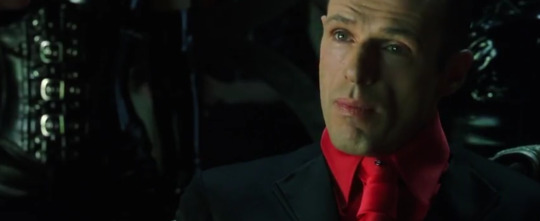
Speaking of whatever he did to the Oracle, Merv says, "Where others see coincidence, I see consequence. Where others see chance, I see cost." What he did to her was business, economics. [M3 0:21:52]
This mirrors what Morpheus said in M2. Though he doesn't see the grandiose purpose and providence, but the mundane consequence and cost--economics in place of fate.
Choice doesn't factor into either of these. Morpheus doesn't believe choice factors in because it's already been decided--similar to how the Oracle thinks. Merv is just cranking the wheel of give and take.
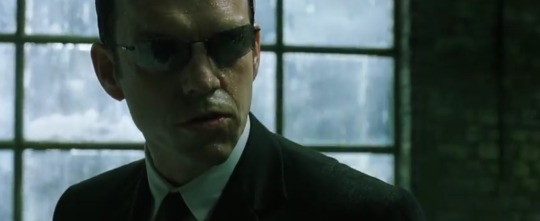
During the finale battle, Smith says "the purpose of life is to end." [M3 1:44:53] Namely by being taken over by him. He aims to take over everything, because he's a virus. And that's a big problem for the Machines.
Thematically, this doesn't really do much. Though it kind of fits into how the fight ends.
Neo gives up and lets Smith take him over. Which allows the Machines to... do... something through Neo I guess? To destroy all of the Smiths? Somehow? [M3 1:52:50]
This could be the choice he didn't understand maybe. Though potentially it could've been the choice he made at the Architect's room--to not create a new Zion, and seemingly allow all of humankind to die.
Apparently he was seeing the door of light in a prophetic dream, though we never saw that so it didn't really have any impact.
Anyway, one of these were this was the choice he didn't understand, that he was destined to make according to the Oracle. Though at the time, it was just pure confusion for the audience.
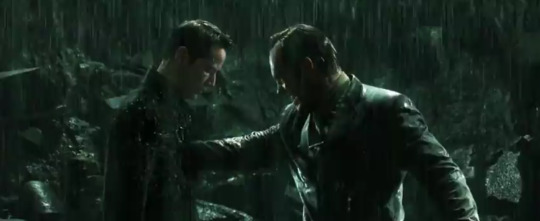
That's really the problem here, thematically. It was pretty much all talk about the theme, but we saw very little to demonstrate any of it.
There were a lot of "let's sit down and chat" scenes in these films. Technically, the exploration of theme in M1 were also conversations--but those conversations happened because of the story. They were directly related to the story unfolding, they came naturally as a result of what came before. They were direct and relevant.
In M2 & M3, these conversations did not come from what came before. They were not particularly relevant to what was happening. They often meandered and jumped from topic to somewhat unrelated topic--awkwardly setting up aspects that would come into play, but with nothing motivating it being brought up.
One speaker would say something cryptic and the other would understand exactly what they meant and say it--because just a monologue would be too obviously an infodump. Or one speaker would change the subject at random and the other would carry on as if nothing weird just happened.
While there were thematic threads linking to the events--well, pretty much the very final events perhaps--the viewer wasn't in on that. And the conversations were mainly used to worldbuild, exposit at the viewers, talk about philosophical concepts.
Just as in M1, the same concepts were revisited over and over, from different angles. But not in a subtle way that was worked into the story; it felt more like the characters were saying to each other:
ORACLE/ARCHITECT/MERV: Hey, you know how the theme of this movie is fate, or purpose or something? NEO: Yeah? SMITH/MORPHEUS: Isn't it cool? NEO: Uhuh.
The visions didn't really do anything but give the writers an excuse to lead Neo by the nose. We care about Trinity potentially dying, and that piques our interest at the start--that's fine. But it has absolutely no impact on the story whatsoever. She doesn't die, and life carries on.
Or is the idea that the only reason Neo chose not to go along with the "new Zion" door is because he had to save Trinity immediately? If Trinity wasn't falling, he would have left her to die by the Machines instead? I don't buy that, personally. It just doesn't all fit together.
This doesn't mean those chats should all just be ripped out. Imagine if this was done with the finesse of the first film...
For example, we could see the choice Neo would make that was incomprehensible. In the dreams, we see him giving up and dying--something anathema to who he is as the One. We see him taking a door that means the end of all humankind. We see him full-on snogging Persephone.
Maybe just flashes at the start--Neo calmly allowing Smith to attack--to keep some suspense. And as his mind returns to it, the flashes lengthen--we see Smith's black goop ooze over him. Stuff like that.
He's worried. He has self-doubts. He's meant to be this all-powerful thing within the Matrix, this saviour all of Zion has been waiting for. Nothing can stop him. But... is he really going to give up?
We're confused by the dream too, identifying with Neo's response to it. We've got something to think about that we actually care about, that will actually have dramatic impact later on.
Now he has something to talk about, with the dream. Oracle tells him they are choices he will make. That he needs to understand the choice. Now it has meaning, weight. The conversation is now relevant to the story, because the story starts with those visions.
There's the hint of the Machines being this sort of strict dictatorship where if you have no purpose, or become obsolete, you will be killed. And there's an "underground railroad" type of thing going on with the Trainman and the Merovingian.
But that's also purely there to spout theme. It doesn't come into play through the story in any meaningful way.
What if Neo actually helped an escaping program--another thing he couldn't understand the choice to do, perhaps. Running from agents or whatever. Some concrete reason why this is happening more now. Perhaps word of a virus sweeping the Machine City--which turns out to be Smith. We sympathise with "the other side" in this war. If only there was some way for both sides to co-exist. ...Which of course sets up the very end.

There are several indications that the Matrix was intended to be about "the future," a future of humans and machines learning to coexist.
But while it's said at the end of Revolutions that's what happens... I certainly didn't buy it. There's too many questions about how that could possibly work, why the Machines would agree to it--especially as Neo said nothing about it when talking to the nanobot-baby.
That ending felt a lot more like a "blue sky" ending, one where you're not meant to think too hard about it, but just accept the happy ending and move on with your life.
The main issue though is that it wasn't set up in the story. It felt bolted-on. If I was properly prepared by the story for this to be a thing, I could've accepted it as a satisfying and earned conclusion.
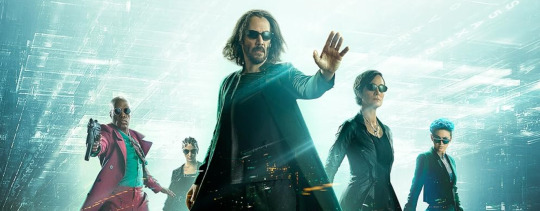
And lastly, Resurrections. (sigh)
There's a whole lot going on in this film. A lot of meta themes, a lot of themes about society, random themes thrown in from time to time and never mentioned again...
To save my sanity, I'm just going to focus on the one with the through-line to the Matrix series itself: "You call this a choice?" As in, that's not much of a choice.
Which is linked to the themes and subtext of M1, I think. But with this darker, more twisted tone. Instead of the surface-reading being "Neo is helped by people showing him the truth, and he's going to be the One, yay!" it's "Neo is trapped in a hell no one else can see and there's nothing he can do about it."
"You call this a choice?" and variants of it, is said throughout the film by various characters...
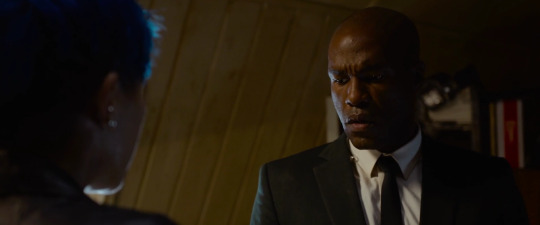
Smith/Morpheus says the choice between a blue pill and a red pill isn't much of a choice. [M4 0:11:22] Bugs agrees, but says it's just an illusion because everyone who is offered the choice is going to pick the red pill. It's offered because the person offering the pills knows what they will pick.
The red pill is there to give the feeling that you are making some sort of choice. But really, as the Oracle put it in M2, "you've already made the choice." In M1, Neo had "already made the choice" to escape the Matrix, by seeking out Morpheus in the first place.
...And then after he was freed, Neo was taught what the Matrix actually is, and so "understood the choice." That's why he went to Morpheus; to understand his "choice" or motivation to "exit" the world. It's a little mind-bendy, but if you squint it sorta works.
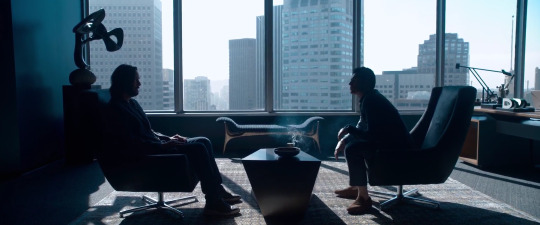
Later, Neo, in Thomas-form, is told by Smith, in Boss-form (yeah I knew this was going to be confusing)... that Warner Brothers has offered the choice of make the sequel or watch them make it. [M4 0:19:43] Thomas doesn't want to lose control over something he's worked so hard to make, so they must choose to make that sequel.
This parallels the apparent situation Warner Brothers put the Wachowskis in regarding this movie, in fact. I have no idea how this whole thing made it into Resurrections, to be honest. But there' a lot of meta nods about this in the film.
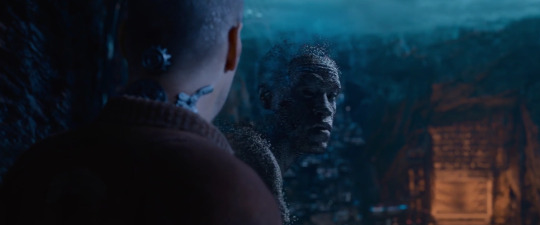
Neo is locked up by old-curmudgeon-Niobe for reasons, and Morph (what I like to call the slightly odd cartoon-character version of Morpheus in this movie) talks about breaking out.
MORPH: Well, I could tell you that they're standing by, waiting for you to make the choice to remain meekly incarcerated... or bust the [heck] out of here and go and find Trinity. But that ain't a choice.
Which is a little tonally different, but if you're going to the trouble of using very similar phrasing throughout the script, then any instance of it is definitely on purpose.
Morph is telling Neo he has to bust out and save Trinity. Neo has kind of regressed. Both in the fact he's back stuck in the Matrix at the start... but also he's not making any decisions in this film, pretty much. He's just along for the ride.
Which is a shame, considering how far he'd come in M1.

Anyway, they run, do some fighting, and Neo chats to Trinity but comes back empty-handed. Back in the ship, Bugs gets a call from the german guy.
SHEPERD: Check your long-range scans. Squids are combing this area. ... You can stay here and die, or come back and face a court-martial. MORPH: And you call that a choice?
They're not going to choose death. So they must go back and get told off my Granny Niobe.
They go back again. (There's a lot of running back and forth between IO and the Matrix in this film isn't there? Seems pretty redundant.) And for no apparent reason Niobe decides to help them get Trinity out this time.
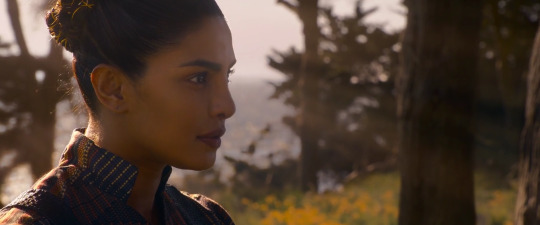
Sati from M3, now a grown up program, talks with Niobe and Neo. Admits that she knew Neo and Trinity were out there somewhere.
NIOBE: I'm sorry, you knew what happened to him? You knew that he and Trinity both were alive... and you didn't tell me? SATI: There were times I doubted my decision, Niobe. But I/O needed you. The city needed to be built, for your people as well as mine. If I would have told you everything, you would have had a very difficult choice to make. NIOBE: My friends let me make my own choices.
Again, the choice was made for her. She wasn't even offered a fake choice in this case.
In Resurrections, this is actually a step up from M2 & 3. The film has a lot of flaws, but there are no sit-down chats about what choice is as a concept, and what it means to have no choice.
The way the theme--or this theme at least--was written into the story worked just fine in Resurrections. It does make it clear what the theme is, by repeating it with similar phrasing each time. But at least it all fits with the story being told.
(The story being told, I didn't find to be that compelling for many other reasons. But let's not get side-tracked...)
In Reloaded and Revolutions, it was just too high-falutin and wordy. Too much philosophy-major, not enough writing-major (or something). I, and others I'm sure, got a bit bored during the wordy parts... but not because it wasn't 100% action, but because the conversations weren't connecting to the story and therefore we had no reason to be interested.
And the way the theme was used in the story--Neo searching for motivation--left the other parts of the story lacking. Because they literally had no motivation most of the time for Neo's storyline.
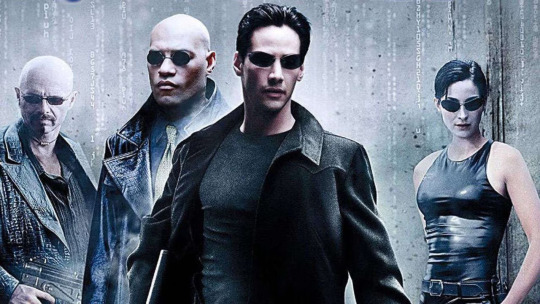
But I think the original, The Matrix, really is a shining example of how theme works.
It's not in your face. Could even be that the writers weren't thinking that hard about themes, and they just wrote the story as they saw it... and my analysis of it is just me making connections anyway. But if they did come up with the theme they wanted to explore and then build the story around it, they did such an amazing job that it seemed effortless!
On first viewing the theme went unnoticed to me. Even by the 20th viewing, I knew it was about choice in some abstract way--where Neo essentially "chose" for the bullets to stop, chose to live, chose to save Morpheus, etc. But analysing what's really going on, what's true and untrue, the undercurrent of manipulation--even if used for good--etc... really let me see the depths of the themes here.
As a side-note, just for me, there's a repeating motif the Wachowskis seem to like making in each sequel, which also rubbed me up the wrong way. I won't go in depth now, but progress just kept on being reset over and over again. Power creep and "oh look shiny new thing" slid the world around over time, making it all feel less solid... And worse, those who were really into the worldbuilding were let down by such changes, and by the writers ignoring what was set up in the previous stories, instead of being rewarded for their interest. Ugh.
Anyway... that's enough from me. Maybe I'll speak more on this series. There's a lot to talk about. Or maybe I'll move on to something else to learn from next!
0 notes
Text
Theme through Story (The Matrix)
This is another review/writing article, this time based on the Matrix series, by the Wachowskis. (Stay tuned for the second part.)
The Matrix has always been a favourite movie of mine. When I first saw it, it really blew my mind! Just the core idea of the world not being what you thought it was, the trippy, all-encompassing surreality of it all was super engaging to me as a kid.
youtube
Great effects, some kung-fu, some explosions... great fun.
It was small-scale, big-concept. It's all about a small group, fighting for survival against just 1 - 3 agents, that looked cool with bullet-time and all that. And the idea of living in a simulation and not realising it brought it this weight, and brain-melting quality in the background of the whole thing.
Now... with my review out of the way, the article will begin.
In this two-part series I'm going to go deeper into the themes of each movie, and how they are expressed through the writing. The themes I'm particularly zooming in on are all closely linked between films, so it's a great opportunity to compare different ways of expressing the same (or at least comparable) theme.
scroll down to find out how deep the rabbit hole really goes ���
Bear in mind, this is written for people familiar with the source material--the "Matrices." If you've not watched them, this will spoil all sorts of things with no warning. And what's more, you'll probably not understand what I'm talking about in the first place.
Films are sometimes referred to by the shorthand: M1: The Matrix, M2: Reloaded, M3: Revolutions, M4: Resurrections.
I'll also leave time codes like this [M1 1:20:34] so you can find the clips yourself. I would embed them as youtube videos, but I'm pretty sure they'd be taken down in a heartbeat.
I'll skip to the end and say, the theme is "choice." Choice as a concept runs through all 4 movies, and is explored from different angles, in different ways in each.
EDIT: After thinking about this more, the theme is "manipulation." That's what's happening in each of the scenes I discuss, choice being just one part. But these situations on the whole are manipulations between characters.
What I'm going to delve into is, how the theme is written into the stories themselves, and how that affects the viewing experience.
Everything here is from my subjective opinion. Yours may differ. I hope that you can learn about "theme" from this analysis either way.
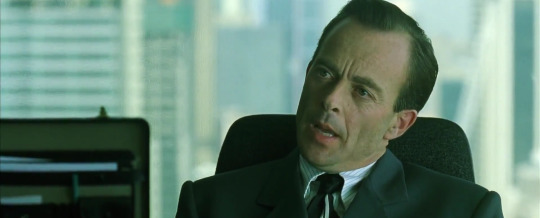
The first scene to look at is... Neo's boss tells him off about being late. Bear with me, you'll see why soon. [M1 0:12:04]
BOSS: You have a problem with authority, Mr. Anderson. You believe that you are special, that somehow the rules do not apply to you. Obviously you are mistaken. ... The time has come to make a choice, Mr. Anderson. Either you choose to be at your desk on time from this day forth... or you choose to find yourself another job. Do I make myself clear?
This is not a real choice. The boss doesn't expect Neo to think about it and choose between these options. He is given the choices, with the expectation that only one of them will inevitably be selected.
The framing of the choices is given by the "truths" that preceded them. As if saying, "Given that you're not special and the rules apply to you"... these are your options, but we all know which you should go with.
If believes those "truths," he has no choice but to go with that first option.

Now, this scene doesn't really do much, on the face of it. It establishes the boss's office, and the window washers' platform, both of which come back in the next scene.
But nothing really happens. You could say you should just cut this scene, or else spice it up to make it actually interesting. But that seemingly mundane, unimportant conversation is setting up something very important theme-wise.
Consider the pattern:
He is told about himself. "You believe that you are special, that somehow the rules do not apply to you."
He is told what is real or true. "Obviously you are mistaken." ...As in, the reality is you are not special and the rules do apply to you. Or perhaps, no one is special, the rules apply to everyone.
He is given a choice to make. A) "be at your desk on time," or B) "find another job."
He makes a decision. "Yes Mr. Rhinehart, perfectly clear."
This time around, Neo accepts what he is told and makes the choice they want him to make.
And that is how his character arc is tracked--we see how he responds to these "manipulations" and "choices." How free is his mind from relying on what others say is true, and therefore how capable he is to make his own choices.
In the first film, this same situation comes up over and over again. And it becomes so clear once you know what you're looking for.
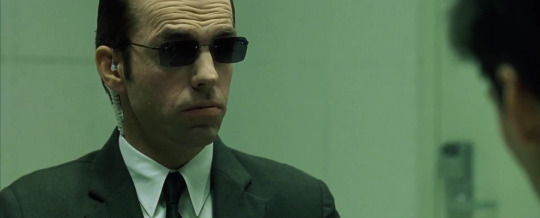
Later he is spoken to by Agent Smith in the interrogation room. [M1 0:17:00]
You are a program writer for a respectable software company. You go by the hacker alias "Neo." You wish to do the right thing. You are interested in the future.
Reality: We need your cooperation in bringing a known terrorist to justice. The meek programmer life has a future, the hacker life does not.
Choice: The choice is implicit--which life has a future? The programmer, who helps us, and gets his slate wiped clean. Or the hacker who's locked away for life.
Decision: How about I give you the finger, and you give me my phone call. He chooses the "hacker" life, and imprisonment.
Smith presents those truths, because if Neo believes them he will choose to help them. It's set up to manipulate Neo into effectively doing as he's told. But, as his boss said, he does have a problem with authority.
Neo rejects Smith's truths, and rebelliously chooses to not help the Agents. He's disbelieving what's presented to him in this case, but the choice is still a passive one. He accepts the inevitable, that he's going to jail, and simply wants his right to a phone call.
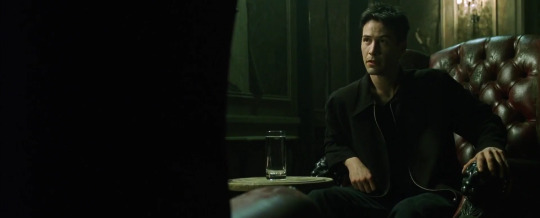
There's only really one time where Neo expresses his own beliefs. [M1 0:26:47]
MORPHEUS: Do you believe in fate, Neo? ... NEO: No. ... Because I don't like the idea that I'm not in control of my life.
While meekly put, Neo believes--or perhaps wants to believe--that he is in control of his own life.
This is how he rejected the belief from Smith that it was inevitable that he'd give up the hacker life and embrace the programmer life. Because he's in control of his own life.
This core belief of his own is key to the movie.
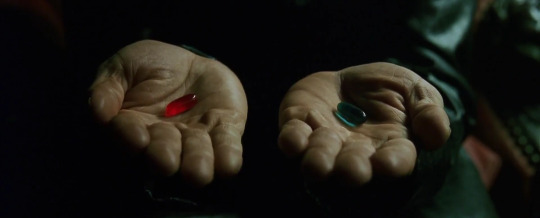
In that same scene, though, Morpheus pulls the same trick as Neo's boss and Agent Smith does.
You feel like Alice tumbling down the rabbit-hole. You accept what you see because you are expecting to wake up. Reality: you are a slave, in a prison you cannot smell or taste or touch. Take the red pill and I will show you the truth. Choice: Blue pill, or red pill?
Blue pills? Red pills? It's so abstract as to have no meaning, and Morpheus doesn't really inform him to be able to knowingly make this decision in the first place. What Neo is really doing is choosing between believing Morpheus (only symbolised by taking the red pill) or not believing him (symbolised by taking the blue pill).
That's the real choice that Neo is making in all these interactions... whether he believes what he is told, or not. And looking at it from the perspective of choice...
"Believing" can be defined as "choosing to know."
People an believe in things that are proven or unproven, true or false. But they choose that it is true, and live their lives accordingly.
Neo doesn't believe in fate, not because he knows fate isn't real. But because he doesn't like the idea of fate--that he has no control over his life. He chose to know--he believes--that fate is not real.
Of course, here, the fact he'd been searching for Morpheus for who knows how long, and has gone through all the rigamarole to even get to speak to him in the first place... means he believes in Morpheus pretty implicitly at this point.
So this choice is more like a formality. A performance, where Neo pretends he knows what Morpheus is talking about, and goes through the motions of pretending to make the informed choice of taking the red pill.
This is touched on in Resurrections when Bugs speaks of her "pills" offer. "The choice is an illusion. You already know what you have to do." [M4 0:11:22]
You could look at it more like a placebo, a way of preparing his mind to be extracted and accept what is happening without imploding--because he "chose" it to happen in some way. A form of consent, while not really understanding what he is consenting to.
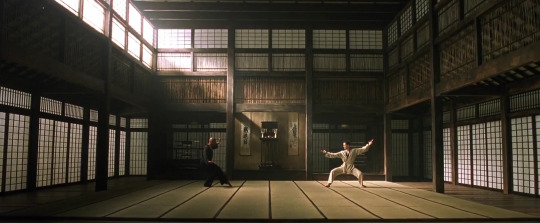
In the dojo, "Morpheus is fighting Neo!" Morpheus tells Neo, "You are faster than this. Don't think you are. Know you are." Reality: "I'm trying to free your mind, Neo." Speed has nothing to do with muscles, in the simulation. [M1 0:52:44]
As they fight, Neo starts to believe that. Starts to "know" he's faster than he thinks.
As Morpheus says at the jump, he is teaching Neo to "let go of fear, doubt, and disbelief." That is how to "free your mind": to believe, separate from anything your senses are telling you, beyond any evidence proving it.
That's his view, anyway. And while it's true to an extent, it's not the full picture.
This situation is made clear with a line from Morpheus in the fight.
MORPHEUS: I can only show you the door. You're the one that has to walk through it.
There's the choice. The only real choice that Neo is presented with again and again.
Morpheus shows him a truth to believe. No one can make someone else believe something by force. Only Neo can choose to believe. Choose to "walk through that door," and choose what options to take as if "knowing" it to be true.
And that is what happens over and over. Doors Neo can take, shown by people who want him to take them.
In Reloaded, the Oracle also shows him to a door--the door of light. Or at least sends him towards it. [M2 0:49:31] And the film is about how Neo gets there, and goes through that door. On the other side, the Architect offers him 2 more doors. [M2 1:56:36] The One always chooses a particular door, so surely Neo will as well? This is meant to just be a formality, like the pills.

Later the Oracle pulls the same maneuver. "You already know what I'm going to tell you." "I'm not the one." Reality: Morpheus or Neo will die. The choice is up to Neo. [M1 1:15:06]
Neo believes the Oracle. Why? Because really she didn't tell him if he was the One or not. She let him decide in that moment. And confirmed whatever he said. So of course he believes her; she only said he was right in whatever he already believes.
And he thinks he's in control of his own life, which she encourages too.
Later, when Morpheus is going to die, he decides Morpheus will live, accepting that Neo himself will die in his place somehow--just as the Oracle said. [M1 1:34:10]
It's funny, the Oracle said to Neo "You don't believe in any of this fate crap. You're in control of your own life, remember?" [M1 1:16:31] But in fact, he's really taken control of his own life because he believes in the "fate crap" she told him. (Stay tuned.)
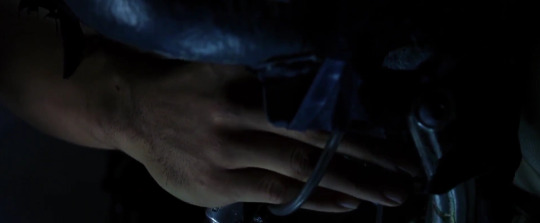
From here on, Neo is on his own. From what he believes about himself and reality, he considers his own choices, and makes his own mind up on what to do.
Neo is not the One. Reality: Morpheus is going to be killed by pulling the plug, sacrificing himself for Neo because he believes Neo is the One. For the first time he really believes he does have a choice. He believes he can simply choose to save Morpheus and he will do so. This allows him to act, to take proactive action to make what he wants to happen, happen.
Later he sees Trinity go down in the helicopter, knowing she will die if he does nothing. But, believing he has a choice to remove the tether and save himself, or hold on and hope to save her... he decides to save her. [M1 1:50:40]
She chooses to trust in Neo in that moment too, which is part of how she is tied up in him becoming the One.
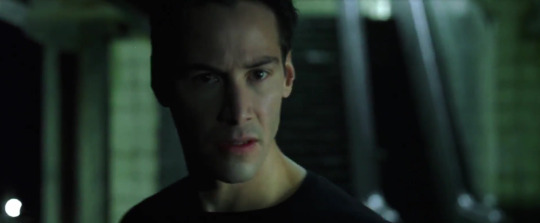
In the subway station, he starts to believe, to know he is the One. He can choose between running from and agent like he's meant to, or fighting. He decides to believe he is the One, and acts accordingly: he stands and fights. [M1 1:54:22]
This rejects Cypher's suggestion that it doesn't matter who you are, you do what they do... "Run! Run your ass off."
Smith tries to manipulate him again on the tracks. He always calls him "Mr. Anderson," telling him over and over that he's just a regular guy who pays his taxes. Reality: "That is the sound of your inevitability. That is the sound of your death." Thomas Anderson has no choice. No one can change the inevitable. [M1 1:57:42]
Neo can choose to accept the inevitable, choose to believe what Smith is saying... or choose that it's not going to happen. He decides with the line: "My name is Neo," rejecting his meek programmer self that goes along with what the world says is true. He hops out the way, Smith is run over. For the first time that anyone knows, someone has beaten an Agent!
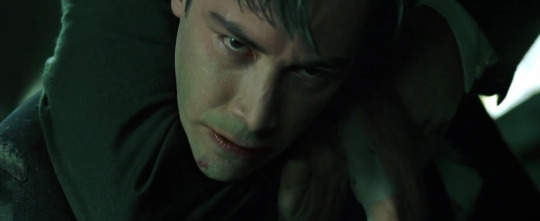
And why? Because Neo chose to. Despite the inevitability. Despite what he's been told is true or untrue. He's beyond that now.
Like the Oracle says, "No one can tell you you're in love, you just know it. Balls to bones." [M1 1:14:14] Morpheus can tell Neo he's the One all day until he's blue in the face and it won't do any good. Neo has to just know it, to believe it, independent of any kind of argument or evidence.
"Know thyself." [M1 1:13:54] Believe whatever you want to believe about yourself. Choose to know something is true about yourself.
And now he does.
He knows he needs to exit so the Sentinels don't destroy the ship. This time he chooses to run. [M1 1:58:31]
In the hallway, Neo knows there's way too many bullets coming his way to dodge. Do they hit? He decides they don't with a simple, "No." [M1 2:04:51]
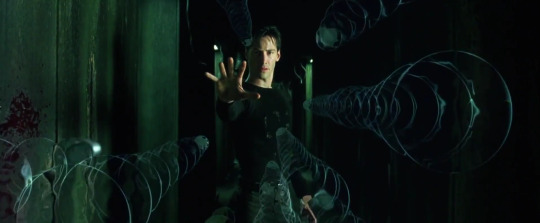
Through all the significant events of the movie, Choice is worked in again and again and again. Neo is told what to believe and given false choices to test whether he believes the "beliefs"truths" or not.
Until he "frees his mind" of what is apparently true, and even what people tell him is true. And makes his mind up, ignoring reality entirely, and essentially deciding what is true.
As Morpheus says, "Your mind makes it real." [M1 0:55:22] Only with Neo, with the One, with someone who has decided that they control what the Matrix does or does not do... it goes beyond the apparent damage to his own body. His mind makes "it" real in the Matrix. "It" being... whatever he chooses is real. He has the ability to "remake the Matrix as he sees fit." [M1 0:45:12] Because he's freed his mind to this superlative degree.
He was dead. That's reality. He--or perhaps Trinity--decided to ignore that and chose to believe he couldn't die. He would not survive three agents firing a ton of bullets at him at once. That's reality. He ignored that reality and choose to believe the bullets would not reach him.
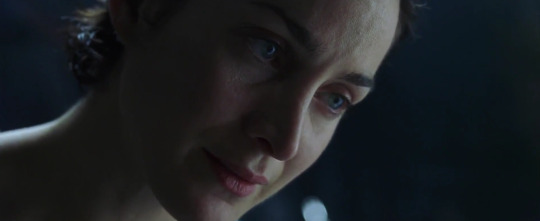
But more than that, the other characters also interact with the theme--in a way that all feeds into the main story line of Neo becoming the One.
Morpheus chooses to know that Neo is the One. Which puts the idea in Neo's head that when he's ready, he won't have to dodge bullets.
Trinity chooses to love Neo, which somehow helps Neo believe. And her kiss saved him, brought him to life, and sort of locked in the fact that he is the One.
Cypher chooses the Matrix as a better way to live. Which is how the situation was set up for Morpheus to need saving, and for Neo to have a choice to make in the first place.
Smith loves "inevitability," where no choice can have any impact. Which gave Neo a clear thing to reject. He chose that he did have a choice. Which is kind of what encompasses "The One" as a concept.

Which brings us to the Oracle.
Did you notice that what the Oracle said was not true? Neither Morpheus nor Neo died. And Neo was the One. It turns out that she's not telling their futures in the first place.
As Morpheus says after Neo saves Trinity: "She told you exactly want you needed to hear, that's all." [M1 1:51:53] Really what she is doing is the same thing everyone is doing to Neo. She tells people what to believe. Why? So that they make certain choices.
All she needs for this to work is for them to believe what she tells them. And they do because she's "The Oracle." I man... she's called "The Oracle," so she must be right... right?
Morpheus goes on to say... "There is a difference between knowing a path, and walking a path." Those that see the Oracle:
Come away thinking they've been told what their path is. They think they "know the path."
Believing that causes them to behave in accordance with that belief. Moves them to make certain choices they wouldn't have made before.
Those choices naturally lead them to "walk the path" the Oracle wants them to walk down.
It's pure manipulation. Just like the Matrix. Just like most of the characters in this film.
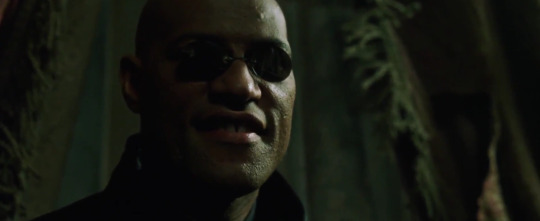
Most of the things people believe in this film simply are not true. Many are false. Some are unproven. But they are believed anyway, and pushed onto Neo to believe them as well.
These "truths," these "beliefs"... they don't free his mind. He still cannot see for himself what is true, he needs someone or something outside of himself--Morpheus, the Oracle, electrical signals piped into his brain--to tell him what reality is.
Looked at a certain way, it's a "prison for his mind" he cannot perceive. People tell him what is true, to make it more inevitable he will make certain choices.
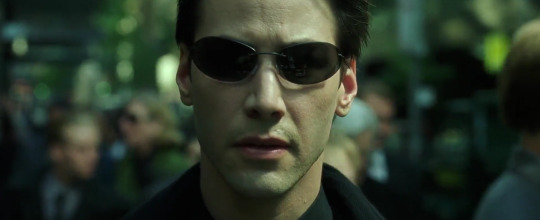
But Neo does get onto the path of eventually becoming the One because of what the Oracle has gotten various people to believe--her manipulations worked.
Finally though, he becomes the One by choosing for himself to be the One. Seeing his own reality, seeing the code around him. Choosing for bullets to stop. Choosing to live. Choosing to fly into Agent Smith, and choosing for Agent Smith to flippin' explode from the inside!
His mind is finally free... of believing what anyone tells him, of relying on others to tell him what is true and what is false, of making choices based on what others decide he should do.
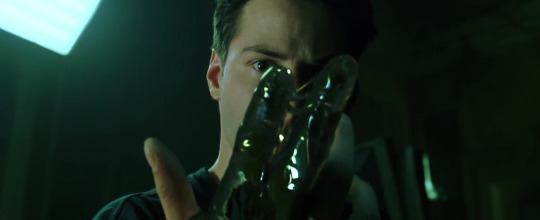
The Matrix is dripping with theme. And there's more to discover along these lines if you look hard enough in just this one film!
But does not beat you round the head with it. At no point is a character just talking about the concept of "Choice" and "Belief" what it all means. It's all-story, all-the-time! And only when you stop and think about it, does it really become clear.
To me, that's the ideal way of exploring theme in a film. Not through exposition, but between the lines of the events of the story itself.
Which brings us to Matrix: RE. (Reloaded, Revolutions, and Resurrections.) Continue reading about the themes of the Matrix.
#The Matrix#the wachowskis#Choice#Belief#Theme#kung-fu#action#sci-fi#mind-bending#cerebral#explosions#bullet-time
1 note
·
View note
Text
How to Satisfy Mystery (Severance, Season 1)
For a little while now, I've been planning on writing in-depth reviews of media. Talking about how the show or movie was written, and what effect that has on a viewer so that we can learn from it as writers.
This aspect works the same regardless of the medium--TV, movie, manga, script, or novel. If there's writing involved, that translates to a reader's (or viewer's) response through the same mechanisms. The "text"--the final form of what happens in the story--gives us a certain experience.
So, hot off the heels of watching season 1 of Severance for the first time, I wanted to give a review.
youtube
First, the spoiler-free version:
The show is intriguing from the start. Are they going to escape? What's really going on? How are their selves going to clash, or otherwise affect each other?
The episodes are well written, and well directed. The core "mechanic" is explored in interesting ways each episode. There's a few twists, but mainly it's focused on the quirks of how the world works for them, and how Severance affects their lives.
The suspense rises to a fever pitch, crescendoing to great heights in the final episode of the season... and then it stops. The season ends on quite a dramatic moment for all our protagonists.
The thing is, that dramatic moment does not satisfy any of the questions raised. The tension that's been building over 9 hours does not get released. So it did not give me any satisfaction by getting to the end of the season.
We are not left wondering "What will happen next?" We're left wondering "What will happen... now? What even did happen? This scene that the whole show was ramping up to... what was it ramping up to?"
It ramped up to whatever happens right after the end of the season. Not what happened at the end of the season. So... nothing happened? It built to nothing?!
And that's my review of Severance, Season 1. But the article doesn't stop here. I'm going to spoil the whole thing, and talk about how the "text" of the show got this reaction out of me. And discuss what we can learn from it.
This is an all-spoilers, no-context kind of article. If you haven't seen the show, this article will both spoil the whole thing and not make much sense. But if you have seen it, it will give you a look into how the writing affects viewers (at least one viewer, anyway), and you can learn some things along the way.
[MAJOR SPOILERS AHEAD]

We start with Helly, a female protagonist who doesn't understand the world of Lumon. Because she can't remember anything. As far as she knows, nothing has happened in her life up to this moment. She doesn't know who she is, or what she is doing here... all she knows is she wants out!

This does a number of things:
1) We're in the same shoes. We don't know what's going on, just as she doesn't know what's going on. The viewer identifies with her. So they care about her story.
Interestingly, she is not the equivalent of the "viewpoint" or "main" character of this story, Mark is. But she still serves as a stand-in for the viewer, someone who needs to learn about this place, and so the viewer can listen in and learn with her.
Through Helly, a mystery is presented: Where is she? Why? What is this place?
So, we have a lack of understanding instilled in the viewer... you could call it confusion. That's what mystery is, for the viewer--seeing something they cannot understand.
The reason any mystery is compelling is not the feeling of confusion. Confusion is easy. Put in random words that mean nothing and you've confused the reader. You can keep throwing random things that mean nothing in there, and never answer it, and keep that confusion rolling as long you want. Good job. They've stopped reading.
It is the expectation of revelation that draws in people. Of finding out where she is, why she's there, and what this place actually is.
A mystery is not a story. A story is made when the mystery is solved.
This thread is developed over the season using various arcs.
Helly is taught how to do her job, which at least appears to be wholly pointless busywork--though this is left open to interpretation. It also seems the management do need their quotas to be met for some reason.
Optics & Design is another department who seem to do equally useless busywork. Ideas of a war between them are stoked by management--though it's indicated that this is to manipulate them and keep them apart.
There are maze-like corridors for no good reason, beyond perhaps making it more difficult for the Severed employees to move around freely.
Punishment comes in the form of the Break Room, where lines are repeated until an observer decides they are genuinely sorry. Likely some level of brainwashing, or "recalibration" going on here.
There's a "Testing Floor." Nothing more to that so far, but the corridor that leads to the elevator for the Testing Floor looks scary, so... there's that.
Goats. There are baby goats. They're not ready yet. Goats.
Each time a new little thing is added to the mystery, it intrigues us more. Why? Because again, we have the assumption that there is an explanation, an answer that makes all of these disparate elements make sense. There is more riding on that revelation. More and more we think "How are they going to pull this off?!"

2) Also she wants out, which is totally understandable. She woke up laying on a conference table--a bizarre situation that grabs your attention from the start. And she is unable to leave. The viewer sympathises with her. They can imagine feeling the same way in that situation. They want her to escape just as much as she does.
While the mystery of what Lumon really is runs in the background... Escape is the main driving force of the show scene to scene.
Helly wants to quit, on her first day, when she finds out that her job is just nonsense. She sends a request to her Outy/original self to resign. This is denied in a way that puts Outys as real people and Innys as very separate but lesser beings entirely.
She tries to get revenge on her Outy self by having her wake up hanging in the elevator, which fails. This is where she gets the Break Room treatment, if memory serves.
She never gives up, but plays along for now.
In the meantime, the others don't want to escape. Dyllan enjoys his work. Irving is effectively a zealous follower of Kier--the founder of Lumon. And Mark is just chill and unbothered. And if anything, enjoying his new role as manager of their little team.
Right near the start, the old manager has left. And meets with Mark on the outside. He's even scaped the Severance, reintegrating his Inny and Outy memories--but with complications.
This is what starts Outy Mark on the path to learn more, and perhaps leave Lumon entirely.
Between those characters and situations, we have more questions presented and explored over the season. Why escape? Should we escape? What do we risk if we fail to escape?
People reason about why to stay, why to go. They talk about the obstacles in the way of escape. New things are discovered about how it might be possible. Attempts are made and fail in various ways.
Petey is someone who... has escaped? In some way? Maybe? Only Outy Mark knows about this, but it dangles that carrot in front of the viewer in yet another way.
This isn't a mystery based on not understanding what we've seen, but a different kind of thread. A... geographical thread? They want to be somewhere else (or they don't want to be here at any rate). And the arc is about how they try to do that and if they make it to the other place.
It's engaging because we want to know what happens next. So we keep watching to find out what happens next.

All in all, great stuff! We get new terms we don't understand, which is fun and mysterious, and then makes us feel smart when we learn what they mean. We become "in on it." These act as tiny little mysteries that are solved easily.
We're presented with new ways of seeing the core mechanic of the show--Severance itself. Is it slavery? Are Outys bad people? Why does Lumon do this? What was the true goal of the founder and his descendants? Which keeps us engaged and intrigued with the idea.
We have drama between Innys and management, and between Mark and... just his own life stuff which is affected by Severance in different ways.
The show stays focused on the core concept. It doesn't lull into just straight drama for too long, and what drama is there is humorous and enjoyable anyway. Severance affects everything, every scene. There's not really any fluff where we just have a scene that writers write to fill out some time in an episode.
And then we come the ending, the last episode of the season, the finale.

They eventually cook up a plan to switch themselves--three of them at least--into Inny mode, while their bodies are on the outside. Not so they can learn about themselves, but to find someone and tell them what is going on inside Lumon. About the hell it is for the Innys, and the weird goings on.
They all agree to focus on their mission. No wandering about or checking out their Outy lives because it's interesting. They need to focus and get the word out.
Inside, Dyllan does the computer things. As he does that, we get some establishing of what the Outys are up to. This builds tension. Particularly with Mark, at the reading party, where we find out Cobel is attending in her "nice old lady" form.
We're thinking, "When are they going to wake up? What's going to happen? Will anyone notice?" The suspense is handled really well.
One thing I'd say is, he has to not just turn a switch. Not just turn 2 switches that are an awkward distance apart. But keep them on. Which in-world sorta seems like a weird design choice on the part of Lumon if they want to be able to turn an Inny on for a while, but also they're not that far apart for an average-sized guy to turn them both anyway, as far as I could see.
(Dyllan is a shorter man, which adds to the tension of this situation as he strains to reach between the switches. If Irving had this role, it would've been a piece of cake, pretty sure.)
I did think, though, that such an enterprising man as Dyllan would've grabbed a pencil, a stick... something to cram into one or both of the switches to make the whole thing easier.
Though he did hold out until one of the management, the main hands-on antagonist, rugby-tackled him to the ground and the switches turned off at the end. So in theory the switches would've turned off at that point either way.
It did feel a bit contrived, but you've got to have something going on with Dylan, right? And it does make the other scenes on the outside that much more tense. So fair enough.
Meanwhile, what does Irving do? He checks out his own life for a while--exactly what they agreed not to do. 🤦 He finds out his dad was in the navy. 🤷 He finds out that Outy Irving has been looking into the Severed employees for some reason. Okay. And he sees he's been painting the corridor to the Testing Floor elevator--which we already knew.
(I think they could have held the painting revelation to this moment, and it would've had much more impact. Though they probably wanted that little reveal where they had it, to keep us going through the quieter episodes.)
Anyway, he decides to go find Burt. Knocks on his door. Then Inny Irving is turned off. That's the only thing that happens. He knocks on a door. Which is to say... nothing happens at all.
What does Helly do? She's at a gala where Outty Helly is the star. She's going to give her story of becoming Severed and how great it is, as marketing for the company and the process.
She meets her father, CEO of the company--effectively the big-bad of the show. This is a great revelation, and really pushes that "Innys and Outys are two completely separate people who want different things" concept they developed through the season. Good job!
The man speaks in this odd creepy way. Almost distorted like through a machine? And he mentions his "Revolving" is soon.
I'd like to pause here, to do a bit of theory-crafting... "Severance" is step 1: literally sever the host's mind from their body. Grow the Inny, cleanse it of Tempers (perhaps this is what MDR does) and develop the Qualities through the rules and lore of the company. Perhaps this is the reason for the almost religious indoctrination measures Lumon puts on within the Severed floor. (The Inny is like a larvae growing inside their body that will eventually replace them--by the original never being woken up again--hinted at in one scene.) And "Revolving" is step 2: insert their own mind into the chip, or swap chips, or whatever. Gaining a form of immortality. Maybe this is the master plan, and why they're really there? Anyway...
Helly calms herself down with the "Forgive Me" mantra from the Break Room, which is a pretty chilling moment. And is determined to spill the beans at her speech. Cobel confronts her and threatens her, but Helly starts her speech talking about the hell that is: being Severed at Lumon.
Again, no real hurrying to tell someone. Though she's in a difficult situation--it's clear there is no one she can trust here. So while I felt a little frustrated watching it, it's more understandable here.
What does Mark do? He wanders a bit--but figures out who his sister Devon is and speaks to her. There's some bait-and-switch stuff with going to talk, then not able to talk. Going to see Gemma's face and realise she's in Lumon, then not. Where's the baby? Oh it's there.
...Stringing us along between scenes of the other Innys. Effectively padding out the episode, but also letting the tension build over time as Dyllan is at risk.
Ricken has a dodgy throat (unclear if this is to become "a thing," or just Ricken being his sensitive self and not used to speaking for so long). Mark speaks to him, gushing about how the book changed his life.
I liked this thread. The idea that platitudes that barely make sense and "you can do it if you believe" encouragement actually can help people. The Innys have never heard such platitudes and pun-based encouragement, and it opens up a whole new way of looking at the world for them. That was pretty cool!
Anyway... Mark finally gets to speak to Devon and--off-screen--tells her everything.
This went the best out of the 3. He had the most focus on the task at hand, and actually did it completely. He wasn't rushing as hard as the tension from Dyllan suggested they all should be, which was frustrating. But something (presumably) will actually happen from this that they wanted to happen from this whole plan in the first place. Because he actually said something.
He does finally discover a photo with him and Gemma in it, realises she's still alive and in Lumon. Which actually we already knew from a couple of episodes earlier. So that didn't change anything for the viewer. And Mark never knew her, hasn't been dealing with the grief over her death for years. So... didn't change a whole lot for him either? All he knows is that his Outy's wife is thought to be dead, but is not.
(I can't remember when or how he found out about Gemma's death, but I'm pretty sure it happened at some point somehow.)
And he blurts it out to the room in this pained scream. (I'm not sure if Inny Mark would react so strongly, but Outy Mark would. ANd it's the end of the finale so I guess that's fine just to ramp up the drama if nothing else.)
And... cut to black. That's where the season ends.

Wait... that's where the season ends?!
What happened to the mystery of what is going on at Lumon? The reason we're enjoying the show so much is because of the promise of some sort of reveal to that core mystery.
Even if they didn't answer the whole thing, something was needed. Something was promised.
Remember how a story is a mystery solved? Severance is currently not a story! We did not get a story, or even a chapter of a story, in Severance so far. Nothing was completed, nothing even worked towards answering anything.
There wasn't even a twist at the end with some new mystery!
(Which would have been annoying, but could have been made to answer things and ask things at the same time if they did it right.)

They didn't even escape. They took one step towards getting "outside." One step towards maybe escaping or being freed later on.
Now, this thread didn't bother me so much. I guess you could say the promise made by "We want to escape" is something like... we see them and the outside in the same shot.
Whether that's because they escaped fully, or realise it's a much bigger undertaking (for season 2) to actually escape, or it's within reach but they fail or die or something. Even a "from the frying pan into the fire" twist where it turns out that the place they want to be is bad in its own cruelly ironic way.
Any of those would close off (to some degree) the promise of "escape." You know, something big that the characters have accomplished or made progress on.
I'd say that them at least seeing the outside fulfills that well enough for me personally. Though I could see it frustrating some viewers--that's fair enough.

The fact is, I have no idea if the makers of the series know how to end a story. How to solve a mystery satisfactorily. That's the problem.
There are a lot of serialised shows (meaning stories chopped into many sections and shown as episodes) that are also mystery shows... that go nowhere, because they just keep throwing in new weird mysteries and never definitively answering any of them, and never tie them all together so it all makes sense to the viewer.
It's actually pretty easy to do that. It's just one step up from confusing the reader. If you don't need anything to make sense, you can say whatever you want and it's just fine. You can keep that going for years, stringing people along with the promise and implication that there are answers that satisfy all of your questions, and they will come... and then just not giving those at all.
(I'm looking at you, Lost.)
A story can be about many things. It can be about the characters, the drama, the relationships. It can be about the plot, the big-bad, the plans and how things-don't-go-according-to-them. It can be about escape or return, about grand ideas, about slavery, democracy, truth, love... your story can be about anything you can imagine.
Whatever it's about, you tell the reader or the viewer what it's about by how it starts, and what you focus on as it continues. If your first episodes starts with a big mystery, if your show continues to add new mysteries to the pile... you are promising that these mysteries are worth being part of the story; you are saying to those that engage in your story that it's worth thinking about that thing.
If you choose your story to be about mystery, the only way it's worth them thinking about a made-up mystery about a fictional world is... that they will enjoy solving the mystery. That all will be revealed, and their theories will be proven right, or they will be enlightened by the answers. That they will savour the satisfaction of understanding what once seemed impossible to explain.
Remember to actually do that, though. It's your responsibility to let them actually learn new things about the mystery, to help them understand what they've been pondering on for weeks or even years. And it's to your benefit to show that you know how to do that in a satisfying and reasonable way.
If you don't, then while you're having fun throwing in weirder and weirder stuff to your mystery box... you're risking people giving up on it entirely and walking away. Especially those that have been let down by other writers who promised the same things you have.
3 notes
·
View notes
Text
Experiential Description
As writers, it can be difficult to know what to put in, what to leave out. What to include, what to skip. What is too much detail, what is not enough. We can get carried away describing an object for pages, or setting the scene for what seems like the whole chapter before anything happens. How abstract is too abstract? How concrete is too much?
How can we find the right balance?

Feedback is always a good way of figuring that kind of thing out, dialing things in to balance it just the way we want it. But there's a certain way of looking at writing which gives a whole new dimension to what it means to write, and also helps a lot with this question.
The writer is a transcriber of experience.
Let me explain...
Think about what is happening as a person reads a story. They see text. They turn it into meaning. The meanings string together to form an experience. The experience of being in another world, of observing people doing things, of feeling explosions knock them off their feet, of having their first kiss.
No matter how you look at it, no matter what style we prefer to write in, we are providing the reader with an experience.

Often the experience we want to give is from one of our characters. We call this the "viewpoint" character.
Or it could be from the "viewpoint" of the narrator, a nebulous all-seeing observer from the shadows that only exists for us to see the world through--or more than that if we want to get fancy.
It could even be some theoretical person we imagine in the scene, purely to be able to put ourselves in their place and think about what it would be like to be there--to experience witnessing whatever goes down in the scene.
We want the reader to have that same experience. To know what it's like to be our viewpoint character in this moment, or at least imagine what it would be like to be there in the room when it all goes down.
This is how they immerse themselves in the story; they pretend it's real, and "remember" being there. How? By taking the text and forming such an experience in their own minds.
The better the text reads like an experience the reader could have within your world, the easier it will be to translate the text into an experience. And the easier it will be form them to immerse themselves in the story.
Now, how does that apply to descriptions?

Think about something you have experienced many times: walking into a room.
When you walk into a room, do you pick up on every tiny detail, scan and analyse every "pixel" you see? Or do you glance about and get a general sense for the space? Probably the latter. At least at first.
So which would describe a human experience of entering that room better: a few pages describing every object in the room? Or a brief overview of the space to give the general idea?
It was a small room, lit only by a crack in the curtains at the far end. The walls were dressed in peeling wallpaper of a long out of fashion floral style, and the two armchairs were positioned to try--and fail--to hide old tea stains on the rough carpet beneath.
Now, that might change. If you were stuck in a waiting room for more than a couple of minutes, you'll probably get bored. You could start studying what's around you, looking around for something interesting. Or poking around whatever's there.
There was a mantle on the long wall of the room, covered in plastic nick nacks from cereal boxes and Kinder eggs. Little men with funny hats. Pigs playing golf. A moon with the face of Elvis embossed in it.
So, more detail may come over time. But not as soon as we enter a space.
That's just how human brains generally work. They notice the big obvious things, the things that catch their attention, the things that are different.
A way to sum up this concept is...
What do they notice, and why?
A woman burst into the room, a big floppy yellow hat wobbling about her head as she locked eyes with his.

If there's no reason to notice her shoes, they don't notice her shoes. So don't describe her shoes. Maybe they can't see the bow at the back of her dress. So don't describe the bow.
The temptation is, you've written out a list of details of how this character looks, and you want to use them all. It's easy for that to turn into a list of facts--as it is literally based on your list of facts in your worldbuilding document.
What you want is to step away from that, and think about the experience of the viewpoint character seeing this. Or what the reader would notice if they were in the room.
This woman might be so captivating--or menacing--to the viewpoint character that they just don't take in much else about her in this moment.

Or they may notice only a few smaller details that make her so captivating.
Her steel-grey eyes glared fiercely. It felt like she was boring into his soul with her stare. He gulped.
If she's wearing a lot of jewelry, maybe they notice that. The bigger things are more noticeable, so have them be noticed first. But they don't notice the gun she's holding subtly at her side.
...Unless something brings their attention to it.
She smiled. "With me or without me?" He opened his mouth but couldn't speak. They were hot on his tail, but could he trust her? Who even was she? She tapped a nail on something at her side. He looked down at a small handgun, half hidden in her skirts. Her tone became more urgent. "You coming or what?"
If you want them to notice something, contrive some excuse for them to notice it. Draw their attention to it. Make it enter their experience.
But if there's nothing else that would catch your attention, just stop. That's fine. That's how we work as humans too. We pay attention to what is immediately obviously important, and then our minds wander.
This gives you a nice natural equilibrium for how much detail to put into your descriptions. Match what you'd notice, what you'd care about as the viewpoint character in this moment. Give them that experience through how you describe things.

Another aspect of this is, it is a person's experience. Not the same as the reader's, not the same as the omniscient writer's... it comes from a person within the scene who has their own thoughts and feelings in this moment. And their own thoughts and feelings on what they're observing.
Sure, you can simply describe a sunset in a factual way--"The sun was low, the sky and clouds tinted orange." But if you saw the same sunset when you just proposed and she accepted you'd experience this moment of seeing a sunset very differently to if she'd rejected you.
This is exactly what the idea of "rose-tinted glasses" is all about. The way you feel colours the way you see things.

These thoughts and feelings warp how we see the world, and how we'd describe what we see or even the situation in general. What words would the character use that reflect those inner feelings? Ask yourself...
What does it feel like to see it?
The blood red of the sunset stained the sky. vs The sky blushed as the sun dipped below the horizon.
Reading a description of the same thing makes you the reader feel those different things, doesn't it?
What would you think about what you're seeing?
They were running out of time--the sun was already setting! vs It was so calm here above the canopy, so peaceful as the sun set. There was no way to tell there was a war raging below.
This is a good way of working exposition into the prose, while also grounding the description to something that matters to the story.
What do they notice, and why?
Hills wave across the horizon, villages of people gathering in the crooks of forests. vs The older towns looked run down from here, showing their wear. How many would survive what was to come?

Different characters may notice different things, too. An architect student may dwell on the Elizabethan decorations at the head and foot of the columns nearby. A world weary con man may pick up on the interactions and power plays between people as he passes them by.
There's a classic exercise to practise writing in this way...
Write about one of your characters walking through a space, and then write about a different character walking through the same space. How does their individual interest change how it's written, what they point out? But you can take it a step further. Have characters with different backgrounds or areas of expertise. But also characters in a different frame of mind. Feeling different things. What happened just before that affects how they see their hometown? What are they anticipating will happen when they reach the end of the street? What is happening as they move through the market that makes some things more important to them than others?

As a personal aside, I really like using light in my descriptions. For setting the vibe of a scene:
A brightly lit ballroom in the sun vs A dark gargantuan ballroom, lit by nothing but a sputtering candle
And also for directing attention:
Light glinted off a blade, as he threw a knife that seemed to come out of nowhere!

A cool thing about this whole writer-reader relationship is... they are involved too. We're writing text that they are interpreting into their own version, their own experience.
So while we can't (and shouldn't) give every detail of everything they would sense if they were in our scene... they have their own experiences, their own real memories to draw on. They will naturally fill in the gaps.
We tell them about a run down music hall... and even if we don't explicitly describe it, they can fill in the texture of the wood floor, the sound footsteps make in the empty hall, the smell of decades of parties and dancing sticking to the walls.
And that actually makes it more real to them. Because part of that completely fictional place is made up of completely real places they know.

Those gaps may be filled a little differently. If I say "sports car" you'll easily conjure an image of a sports car, even if it has a different colour, different shape... maybe you have a specific brand or model in mind that I don't.
But whatever they're visualising in their head is way more real than anything you could describe in the text. It has real world physical lighting and reflections, the undulations of the body panels are perfect and beautiful, the colour has a brilliant vibrance in the sunlight, or moonlight, or whatever place the reader put that car in.
And they'll do that for you, make the world more real for you... for free!
There's a saying in horse riding: "Give the horse its head." When terrain is tricky and hard to navigate through when there's a horse in the way so you can't see it... remember that the horse knows how to walk. The horse can see what's down there, and knows how to move over tricky terrain. So don't try to control every step, by pulling their head this way and that... give them some slack, let them do their thing, give the horse its head.
(Note, this is my understanding of it, but I'm not a trained rider.)

The reader knows how to imagine things. The reader knows what a sports car looks like. Don't hold onto their brains so tightly that they get bored of the over-detailed descriptions. Give the reader their head. Let them fill in the gaps.
Now, if you later assume certain things about this sports car, like it's yellow and has a spoiler on the back... it's going to be real awkward for the reader if they've imagined something different when you gave them some wiggle room.
Their brain, even if it's fast and subconscious, has to rewind and playback the scenes with a yellow sports car instead of the red sports car they had in mind. That takes them out of the flow, it breaks the reality of what they were experiencing.
So, don't just leave it wide open to whatever they fancy--define what needs defining, if you rely on some unspoken context be sure to plant it earlier when you first showed them that detail.
(Read more about the idea of context and continuity.)
But also, it's okay for there to be gaps. Let them fill those in with their own imagination and experiences to the table. Let them make it real for themselves.

Metaphor can get to the heart of the vibe.
Descriptions can use metaphor and simile to help indicate these more abstract "vibes."
The car crouched in the old garage, as if ready to spring to life at any moment despite the dirt and dust sheets that covered it. Beside her, her husband snored like an agitated hippo.
Though using metaphor simply to describe the thing isn't so useful.
The car was as red as a rose.
What is that even trying to say? A rose can be red. A car can be red, like a rose can be red. But it's not clear there's anything meant by the metaphor beyond that.
If the meaning you're going for is "it's red," then you can just say that rather than imply there's some deeper meaning that makes the reader scratch their heads trying to interpret it.
In theory you can twist it to have some meaning if you wanted to, with some more context around the description. But without that, it'll only serve to confuse the reader and waste time.
Make sure a metaphor adds to the experience, not just reiterates it.

Verb choice can describe more than the action itself, too. Actions can include metaphor.
Light sliced through the room. Light poured in through the open curtains. Light beat down upon them, making them squint and squirm.
The verbs "sliced," "poured," and "beat" don't really make literal sense. Light "shines," and that's kind of it I guess? But we understand that the light is shining... in a "slicing" kind of way, and so on. These metaphorical verbs give very different impressions of the light, how it feels to see it, or be in it. The verb itself "describes" that feeling, describes an emotion. Makes the action more experiential.

These ideas apply just as well to any description, any scene, any situation really. Think in terms of the experience of being there, and try to give the reader that.
This actually means a more "lossy," incomplete representation than you may think. A representation "tainted" with the person's biases, feelings, all of that stuff--that's what makes it feel like a real experience. Seeing it through their lens. The slight wonkiness we bring to the table as subjective beings.
Real, hard facts don't make it feel more real. It's the ways reality bends to our perception that makes it feel real and grounded. Or to look at it another way, our goal isn't to make the world feel real and concrete, but to...
Make the experience of the world feel real
...by giving the reader concrete details, in the way a person seeing them would see them.
Seeing such descriptions as more than descriptions, as character, as history, as emotion... makes the descriptions part of the story, part of the experience. It has more meaning than a list of facts.
It becomes worth writing, worth studying and finessing. And it becomes worth reading, worth experiencing for the reader. Worth reading.
#light#description#adjective#verb#action#experience#emotion#feeling#thought#lense#lens#rose tinted#notice#immersion#observe#sense#metaphor#simile#exercise
3 notes
·
View notes
Text
Tense and Timing
Have written, wrote, write, will write.
The "tense" of a word shows when an event happens in relation to "now." Past tense happened before now, future tense happened after now, and present tense happened... right now in this moment.
There are lots of complex tenses, but I'm talking in this article about writing fiction stories. So I will focus on what's useful to writers in that area--hopefully in a way that is easy to understand and put into practise.

People generally pick up on how various tenses work just by everyday reading. And we all generally do fine, even with the nuances and caveats. But when we come to take writing more seriously, to think about how things work grammatically, we can start to get muddled up and unsure of ourselves.
That's because there's an extra little wrinkle for prose. In our everyday conversations, we all know the reference point now, the present. Anything we are saying is happening "now" is happening in the present. So that has the present tense. Before now is the past, after now is the future. Simple.
But in a story the "now," the [current time], might be written in a different tense. Usually present tense or past tense, for most fiction. Because it's a decision we are making on how our story is written, we start consciously deciding on how other parts of the text uses different tenses.

We wonder, this looks like the wrong tense, but is it? If it is, how do I fix it? And which tense should I choose? What's the difference between them anyway?
We'll start with the basics. Past, present, and future...
"I eat" [present] tells you that in the present something is in my mouth being chewed.
Past
Say I'm telling you in the present that I ate before now. I would say "I ate" [past] instead. Eating happened in the past, so I use the past tense form of the verb.
If I'm telling you that I slept before I ate, then from the eating reference point the sleeping happened in the past. From the time I'm speaking from, we go further into the past to eating [past], and even further into the past to sleeping [past + past]. Double-past! 👀

Although "sleep" doesn't have a double-past form. Verbs just don't have a version that indicates [past + past]. You can go back in time to "slept," (or "sleeped") but that's as far as you can go... without help!
In english we have [present] verbs and [past] verbs, and use extra words to push them into earlier or later slots of time.
We can push a past tense verb further into the past by using "had." I would say "I ate" [past] "after I had slept" [past + past]. Or, depending on the situation, other words that do the same kind of thing.
Sleep [present] Slept [past] Had [+past] slept [past]

Even Past-er-er
What if you did something before that? Before now, I ate, before that I slept, and before that I brushed my teeth. That would be [past + past + past]. How would that be written? "I had brushed my teeth... before I had slept... before I ate."
Notice how "brushed my teeth" was written in [past + past] the same as "slept"? That's because there is no [past + past + past]. You can't just use more "hads" to push it even further into the past. You can go up to two pasts, and no further! Thems the rules!
So you have to really spell it out: "I had brushed my teeth before I had slept before I ate." And yes, that does look real janky. That's because we don't naturally speak like this, stacking things further and further into the past. As human beings we think of things happening in time order, from furthest back, to present, to future, one after the other.

So we'd start from a specific time, and work our way forwards. "Last night [starting point] I brushed my teeth, then slept, then ate." Each "then" says "in relation to the event on the left, the event on the right happened later."
It sort of collapses into something simpler, regular ol' past tense. Which is actually called past simple tense. This is the [past] we used before; "I ate" was also in past simple.
Whereas the [past + past] is the most past-est past you can get--the perfect amount of past out of all the pasts in fact! This is called past perfect tense.
(I do know these technical terms, but I just think of it in terms of being past, or double-past. Far easier to understand in my opinion.)
Alternatively, you could write it as "Last night [starting point] I brushed my teeth before I slept before I ate." The events still all happened in the same order as before, but the timing relative to the next event in the list. Each "before" says "in relation to the event to the right, the event on the left happened earlier."
This version also looks very odd, because again us humans think linearly, one event at a time. And we don't read the next thing before the previous thing... so using "before" like this means we actually don't know when anything took place until we read the next part. That's why it can feel awkward to read "this happened before that."
Really we tend to talk about events in terms of one thing happening after another: and then, and then, and then. But this technically works. Just an interesting quirk to think about.
Future
Future works similarly. "Later this evening I will [future] brush my teeth, then sleep, then eat." We use the present tense--the closest one we have to the future--and add "will" to indicate the tense. Because, again, verbs don't have [future] tense forms--just as they don't have [past + past] forms.
(There is the "perfect" future tense, but it rarely comes up. So I'll leave that to your gut feel for how it's written, and you'll probably get it right anyway.)

Fuzzy Tense
There is another type of verb we haven't looked at though. A version of the verb that doesn't even care about time. They hang out in this timeless [fuzzy] area where instead of describing a specific action that happens at a specific time... they're a lot more loosey-goosey about the whole thing.
The technical term for this is continuous tense. These are usually gerunds: words with an "-ing" on the end, like "eating," "sleeping," and "brushing teeth." These can be mistaken for present tense, so I thought it would be a good idea to cover how these work too.
The little boy is in the park swinging, and see-sawing, and playing in the paddling pool.
These are used when we're not talking about a complete event. If we use the swing at the park, we are "swinging." Because we didn't just have one singular swing and stop. You could say the number of times we had a swing is [fuzzy]. We just weren't counting! So "swinging" leaves the number or amount of repetitions unspecified. We "continue" to swing over some time.

These also don't carry a tense, so again we can indicate the timing in other parts of the sentence. "He was[+past] swinging[fuzzy]" pushes the verb into the past. "He will be[+future] swinging[fuzzy]" pushes the verb into the future.
As a narrative example...
I left[past] the room, swinging[fuzzy] the door shut behind me.
There's a definite, non-continuous, complete, self-contained action shown at the start: "I left the room." By the end of the phrase, I am no longer in the room. That simple. Past simple in fact! 🎉
But tagged onto that period of time (between me starting to walk, and me being out in the hallway) is another action. The door swings shut.
Now, I did say "the door swings shut" which is not continuous. It's a complete action that happens once, and job done. But it's not specified at what point in time during the "leaving" part the "door swinging" part happens. And the writer (me) has chosen not to nail that down. I've just indicated they both happen around the same time. It's still [fuzzy].

To compare, let's see how else you could write the sentence with the same timing, but not using this [fuzzy] tense.
You could say "I swung [past] the door shut as I left the room." That has the same meaning, sure.
But to me, the main action going on is me leaving the room. The door being shut is secondary, not as important. So I'd rather have the important action first. "I left the room while I swung the door shut."
This works too, but the "while" (or "as") is saying "the action on the left happens during the action on the right." The action after it is more important timing-wise; the leaving is timed relative to the swinging. It's a little awkward, in the same way "before" is awkward, and for the same reason.
You could do something like "As I left the room, I swung the door shut." This also works. But weakens the act of leaving the room. It's no longer its own clear action... it's dependent on the door closing, for the "as" to work. Again, putting more weight into swinging the door shut. And again, timing things relative to what comes later in the sentence, like "before" and "while."
So I would prefer to put the important action first, and tag the secondary stuff on afterwards making it dependent on the main action. Like: "[primary] I left the room, [secondary] swinging the door shut behind me." Making the swing [fuzzy] lets it borrow the timing from the main action, making it dependent on it, and keeping the focus on the main action too.
And so it becomes a "continuous" form of the verb.

I think of [fuzzy] or "continuous" actions as things that can't be pinned down to an instant in time. Either because...
The timing isn't defined by the text. Because it is unknown like "The wheat will be growing well this winter." Or just doesn't matter as in "I left the room, swinging the door shut behind me." The period during which the action happened might be indicated (the door swung shut during the process of leaving the room), but not necessarily.
Or because it's not an instant in time. The verb captures many instances, like "swinging on the park swing." Or it's not something that can be counted in the first place, as in "I gazed at the water flowing through the gutter."
In-Tense Writing
Now that we know what tense even is... let's get back to the whole reason we're here. Writing prose.
While some genres more commonly use a particular tense, these things come in trends and waves and can change over time. Really what I'd suggest is to write in whatever tense feels right to you.

Me personally, I write in past tense, and that's mainly what I read. Because that's what I'm used to, when I start reading a story in present tense, it feels awkward and weird... at first. But over a chapter or two I get used to it and it's just fine.
Some people giving you feedback might say you "should" use this tense or that, but that might just be down to personal preference or what they are used to reading. It's not a good reason to change your whole text into a different tense.
You might even change tense for certain scenes--for example, writing in present tense but past tense for a flashback. Or you may reframe the time of the flashback as the new [current time] and continue to write in the same tense for that scene.
No matter which tense you use, events that happen before [current time] are written in the [current time + past] tense. And events that happen at [current time] are written in the [current time] tense.
And events that are talked about happening after [current time] are written in [future]; this doesn't change when you write in different tenses. And [fuzzy] just does its own thing either way.

With stories, the writer must choose which tense to write it in. Present tense is straightforward: it's how we speak day to day. You use the tenses just as they are described above. You could see it as providing more "immediacy" to your writing, because it's kind of all happening "right now."
So in present tense [current time] = present. Swapping that into the before-current-time from above, [present + past] = past tense. This is all a bit obvious... but for completeness I thought I'd point this out.
That said, past tense is a very common. It makes the story's [current time], the time it is talking about, have the past tense. Apparently this is used for a lot of fantasy stories, like stories "feel like" a story being told to you in past tense.
Again, I really don't think it matters what you choose. I don't think there are actually pros and cons to either present or past. Either way, some readers will like it, some readers won't be used to it. So don't base the decision on that. Just choose what feels best to write in to you.
Just as before, [current time] = past. Therefore, before the current time, [past + past] = double-past (past perfect). Note that [future] is still future, skipping over present. And [fuzzy] does whatever it pleases.
Future tense isn't really used apart from experimental stuff. So if that's your thing, I'm sure you know enough to be just fine. And double-past tense isn't a viable option for the main tense that [current time] uses. Unless, again, you're a mad scientist (see above).
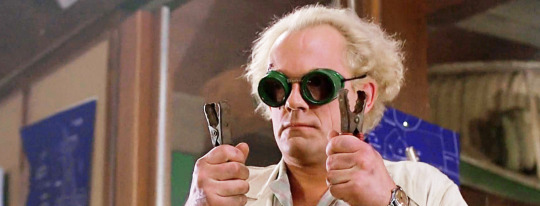
I hope this article gives you the groundwork you need to know what tense you're looking at, how to write in the tense you choose, and how to spot something that feels off and figure out why.
I hope you have a relaxing, tense day! 👍
1 note
·
View note
Text
Story Building
How are stories built? There are structures out there you can use like "Chase the cat up a tree" or "The Hero's Journey." There are character sheets and questionnaires. There are beat sheets and instructions and rules.
But there is no one way! There are no rules. If you don't follow a set structure, that doesn't mean anything bad will happen or your story won't work or you'll never be able to publish it. There are plenty of books out there that didn't follow an established, rigid series of steps.

There are ways of understanding story and its construction that do not dictate the form your story takes. Principles that underpin those processes and methods that are put forward to writers. Ideas that apply to whatever methods you prefer, or whatever you come up with yourself.
This article explores these principles, and how structures and stories and worlds can come from just a couple of simple concepts.
I have demonstrated these methods using the TV show Andor as a guide. So you can see how we can go from a seed of an idea, into a story, and how it could be developed into a final story. Read that for free on Medium.
Motivated Details
I am a discovery writer. A "write by the seat of your pants"-er. A "gardener." I prefer to build the world, the characters, and the plot as I write the story itself.
Note, the principles discussed will be applied for outline writers too, so stick with me for a minute...
That doesn't mean I don't think about how it's all coming together, how things interrelate, how the story is structured. I just don't do so ahead of time.

Most discovery writers simply do that as part of the editing process. Though, in my own process I keep track of what I've built in the prose by keeping a worldbuilding document just as any outliner would.
While writing I might feel like a new character should be in the scene, so I write about them doing things and interacting with my viewpoint character. Then after the writing session is done, I skip over to the worldbuilding doc and add the character in there--including what I've established about them in the story, and perhaps expanding on it a little bit. And I do this for any new details or ideas that came into my head while writing.
Why do I do this? So that I can bring them back later. I can work them into other parts of the story.
Most discovery writers may not do this part. But they still have the story floating around in their heads. And new ideas for what can happen next is based on what happened before. So it seems their minds are working like this as they write even if they aren't specifically taking notes to facilitate it.
There is a principle put forward by Russian writer Anton Chekhov, to playwrights: If you hang a gun over the mantle in act 1, it'd better go off by act 3. Because if something as evocative and heavy with intent as a gun doesn't go off--or more generally play a part in the story in some way--then why hang it over the mantle in the first place? Why even bring up the gun?

Think about it like this... the writer has full control over what is in their story and what is not. What is described and what is not. Writing that a gun hangs over the mantle is a creative choice they made. Why did they make that choice and not another choice? There must've been a reason.
A given detail in the story being included is a promise to the reader that it was there for a reason.
Not everything in a story will have major significance. Maybe a character's hair being blonde vs brunette was chosen on a whim, or the character reminds them of someone they know who has blonde hair and that's all there is to it.
Most things will have some significance though.
The painting hanging up that is turned to face the wall.
The bullet casing that has rolled under the rug.
The handbag held tight at all times.
They all mean something even if it's not obvious at the time.
Sometimes it's obvious why it's there--the light coming on is described, so that the characters can see.
Sometimes it's not so obvious--a pen that seems out of place turns out to be a planted bug, spying on the study.
And sometimes the reader is presented with one meaning, but a twist later on shows them more of why that detail was there! Turns out the light switch alerted the FBI to their safe house being infiltrated.

And when that meaning is revealed, it's like a key unlocking a new understanding of the story for the reader. As they go through the story, more and more connections are revealed, both to the plot and to other characters and backstories and tiny details hidden in plain sight.
This is what stories are made out of. This is the underlying structure regardless of whether you used "The Hero's Journey" or made it up as you went along.
Growing Connections
When I make notes in my worldbuilding doc, I also think about how these details could affect things. Why that detail is there. What the detail could cause. What drama can be dragged out from it. And what further questions arise.
The woman clutches her handbag tight all the time. Because she inherited it from her mother who, even on her death bed kept it with her--a mystery even to her daughter. Why did the mother do that? How does it affect her everyday life? Her relationships with others? What friction arises from this constant eccentricity? Maybe it could be snatched from her on the subway--which doesn't just have the drama of the crime, but also the loss of something that represents her relationship with her mother. What would she be willing to do to get it back? How does she react in this moment?
This usually takes the form of just a few bullet points with ideas for things that could happen in the story related to this detail. I'm a discovery writer; these aren't hard plans for scenes. Just ideas I have while expanding on the existence of this detail that I might draw upon for ideas on where to go next in the story.

Of course, this applies not just to characters but objects (like Chekhov's Gun) or events (this happened, which foreshadows what might happen later on) or places (which characters are from there? will we go there in the story?).
As I write it, I don't know the real reason the detail cropped up in the story; I just let whatever comes to mind come out, and see where it goes. And all I do is reach out little feelers, little lines that might connect to other parts of the story when it again feels right to do so.
If I'm writing about her travelling to work, and I feel the time is right, a shifty guy in a pulled-down hoodie boards her car and it all kicks off. And I find out what she's willing to do in that moment--and so, how it fits into the rest of the story, etc.--as I write the scene.
Then I've got 2 details: the woman's handbag, and the event on the car. Two points of the story connected to each other by a line.
Now I can expand on that event in my worldbuilding. Who was that guy, and why did he do what he did in the first place? What is foreshadowed by his event? How does this change how she views that bag and her relationship to her mother? More details, more points, more ideas that may connect to other parts of the story, and grow out the web.

If this connects to a new scene, a through-line, a plot is forming (whether it's the main plot or a sub-plot). The world becomes bigger, more complex. And with it, the story develops too.
That's all there is to it, really:
Come up with a detail.
Ask questions about it, motivate it--come up with reasons for why it's part of the story, what role it might play.
Link it to another detail (or a new detail).
And repeat, until you've formed a spider's web of links that you can flow through in a single line to find the story.
Supportive Details
This way of growing details out and linking them to one another has a side-effect, too.
Think about why certain scenes or even lines have more impact on you as a reader. It could be a couple of things:
It is supported by, and relies on, is dependent on, a lot of the stuff that led up to it. As in, things that are in the story, part of the reader's experience, resulted in this part of the story.
The mother that 1) dies saving her son from the villain that 2) has hated her for 5 years because of a 3) heated argument over getting a motorcycle when a decade earlier 4) her husband, a long-term, die-hard biker, died on the road to a 5) drunk driver who (for whatever reason) is 6) coming to kill his kid. (Don't think too hard about this story, it's just to demonstrate.)
Each layer twists the knife further. The more details support this moment of the mother dying, the more cohesive the story is working to create this moment, the more weight there is behind it... the harder the moment hits for the reader. (This can be good things, bad things, anything really.)
And/or it supports, and is relied on, and is depended on, by a lot of stuff that comes after it. Things that only work, only happen because this detail is there.
In the accident, the drunk driver lost his lover in the passenger seat and 1) years later comes to blame the biker who died in the crash for his lover's death and so 2) goes after the man's family, 3) after the son leaves home estranged from his mother he focuses his vengeance on the son 4) attacks but fails and 5) the mother tries to intervene, protecting her son but 6) being killed in the process.
Each new thing that happens because of that first detail makes that detail even more vital to the story. It carries more weight. And, while this moment comes right at the start of the story and so has limited impact from how it's supported... it incites the entire thing.
In the reader's mind, this will have big repercussions. They may imagine what will happen in later parts of the story, look forward to seeing how it plays out, and keep reading to find out.
Every part of a story does this. It relies on established things, and it incites new things--big or small. And this process of creating new details based on old details naturally puts a focus on that. And so you can naturally create these webs of establishing and dependent pieces and find the story it all tells.
Planning
Outline writers do the same, but develop this web of connections before they write the prose.
Instead of writing a scene about this woman, and stumbling on the detail about the handbag... you might start with have the idea for the woman and the detail first. And build out the rest of the story from there.
Discovery writers will often have some "seed" they start from too. But from that, they just start writing to find the rest--that's the only difference.
If you're not sure how to build a story, that's all you really need. A seed to grow out from.

Starting from a character, they'd only be part of the story if they are interesting in some way.
Ask questions about it--what makes that character interesting?
Link those details to specific events or objects or characters or places--creating new details in the process.
Now what makes those things interesting? Etc. Etc.
The story is in the way all these things are connected. The plot is the through-line of connected events that weaves through it all.
Beginning, Middle, End
There is one other principle that helps define a story, or even an arc within a story. And that's the idea of a beginning, middle, and end. Everyone's heard those are what makes a story, even as a child in school. Though that alone isn't very helpful.
The important part is, those three are connected narratively to one another. They are the through-line that links everything else. They are the simplest form of establishing and dependent details of the story as a whole.
Think of a murder mystery. It starts with a dead body found. (Or, at least, kicks off at that point. The inciting incident.) What does that tell the reader? As we've been talking about, the body is there in this story for a reason. The most obvious reason? To find out whodunnit.
See how the beginning implies the ending?
The beginning is an event, a detail like any other as we've discussed. It's a special one though. It links to what comes next, how characters react and what they decide to do. Its influence smears out forward through the story.
But also it links all the way to the ending of the story.
Because based on what happens at the start, the reader starts to look forward to what the ending might be. And they get a clearer picture as the story goes on.
Just as the start leads on to what happens next, the ending links to what steps led to it. As a different example, if the big-bad is defeated by the heroes, the heroes had to get there to begin with. So they had to find out where the big-bad was. Maybe discovery a hidden entrance, or fight guards along the way. Did they need a mcguffin to defeat the big-bad? Where is that? How did they discovery they needed it? Etc.

But again, the ending is special. The ending must come from a beginning that implied it. If you started developing the story from the idea of Poirot running down the list of suspects and finally accusing someone of murder... then of course the story should start with that murder and not knowing who committed it. Of course the middle of the story is Poirot figuring out who did it, so he can accuse them at the end.
It smears out back through the story all the way to the start of the story.
If it ends with a twist, the thing that makes it a satisfying twist and not a random spanner-in-the-works is... it was implied. It was hinted at, though it wasn't obvious what it meant at the time. Those hints are usually spread out through the story too, building up support for the twist without tipping of the reader.
So the beginning implies the ending, and the ending implies the beginning.
Now what comes in between?
In between is the struggle to move from the beginning to the ending. In whatever form that takes. Could be the main character wants to move to that ending, and overcomes obstacles to do so. Or maybe they struggle against the inevitable, while they're forced down that path.
Could even be that the literal physical events seem to disagree and not work together, but the metaphor of what they represent work perfectly.

Poirot investigates clues, interrogates witnesses, doubts and believes and doubts again. On the road from finding the body to declaring the killer lies the ups and downs, obstacles and small victories, untangling the web of deceit and obfuscation. Until finally the through-line is clear, and the beginning is "solved" by the ending.
The writer of such a murder mystery must create that web, tangle it in interesting ways, and develop that through-line. As well as mark out where the through-line begins and ends. Just as they would for any kind of story:
Luke dreams of heroic adventure. In the end he's declared a hero. And in between, he becomes that hero through his adventures.
Neo is woken up by Trinity. In the end, he's "fully" awake, and free. In between, he struggles to accept (and "wake up to") who he really is.
Meg Ryan looks for love, and makes a connection. In the end they get together. In between, they get to know each other, they hate each other, they love each other.
Why the set structures work.
Remember all those more prescriptive instructions that are out there? The structures, the beat sheets, the character questionnaires? How do they all fit in?
You can think of them as a premade web of connections--usually focusing on just one aspect of the story and leaving other parts of the web to you.
Character questionnaires are premade "fill in the blank" details with the intention that you start connecting them to other things afterwards. What's your character's flaw? What's their hobby? What's their "quirk"? (And a load of factual stats to fill in.)
Structures or beat sheets are premade connections between events, plus where the through-line begins and ends. These structures can often be retroactively laid over existing stories, even if they weren't written using those structures. Even if they weren't written using any established structure.

You can follow those things step-by-step. But they are simply instantiations, versions, interpretations... of a much more fundamental principle that can be applied in other ways. So feel free to start there and go off-script, or just feel your way around to finding the story in any number of other ways.
People do that all the time--other discovery writers like me. But anyone can do it, regardless of their own writing style or methods or process. Hopefully now that you have an understanding of the principles behind story structure, you'll be able to do so more confidently!
9 notes
·
View notes
Text
Show and Tell
There's an age-old adage taught to new writers: "Show, Don't Tell!"
Some take it to mean they should remove all talking, because talking is people telling each other things. Some take it to mean you can't have anything happen off-screen, you have to show absolutely everything. Some say all text is telling, because it's not an image. Some say all prose is showing, because the reader has to imagine it one way or another.
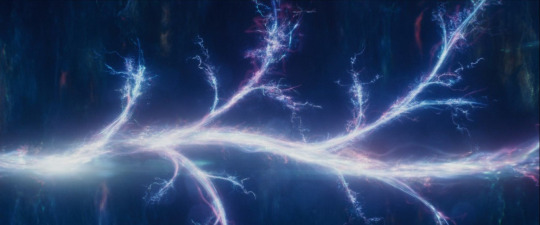
...Phew!
There are hundreds of ways people interpret this phrase, and unless they understand it correctly, writers can quickly find that it's just not feasible to write in such a way. There are many who have concluded that "Show, Don't Tell" is simply bad advice and should not be followed and offers writers nothing.
Why are there so many ideas on what this simple phrase means? Is it good, or should it be discarded from writing vernacular? What does it mean to "show"? And what does it mean to "tell"?
To get to the heart of what this advice is talking about, I give you a simple example:
She looked rich.
Is this piece of prose "telling" us something or "showing" us something?
Well, let's try visualising it. She could have fancy hoop earrings. Or maybe glittering diamonds around her neck. A long flowing white gown? Maybe she's more of a modern celebrity type, in a tailored suit, slicked-back hair and shades and pouting botoxed lips.
Hrm... the text didn't really narrow that down for us did it? She could look like anything. It is telling us that we would conclude the woman is rich based on what we see. But it doesn't show us what we actually see. So... we could be seeing anything.
Consider the difference if instead of text, someone gave us a photo of a rich woman.

This is Salma Hayek. She's a woman. She's rich. But in this photo alone, it's not obvious that she is rich. She doesn't look rich here. If someone told us "there once was a woman who looked rich," we probably wouldn't come up with this kind of image in our minds.
This is showing us something of course; it's an image. But it's not showing us something that is likely to have us conclude that "she is rich."
Now if we tweak the image a bit...

Okay, so sparkly jewels and an expensive coat is probably more in the ballpark. She may not actually be rich--those diamonds may be stolen, or fakes. This image doesn't tell us any hard facts regarding her finances.
But I put it to you that she looks rich, at least. And I'd say that most people would come to that conclusion when shown this image.
Now to put it in terms of prose...
Diamonds sparkled about her neck and hands, and a long faux-fur coat draped over her shoulders, swaying as she walked.
This isn't described to the tiniest detail; there are still aspects we would fill in with our imagination like height, dress, what the specific jewelry looks like. But when we visualise this woman we know for sure that she's wearing diamonds and a faux-fur coat. And we could easily conclude that "she looks rich."
That's the difference between telling and showing. One skips to the conclusion, the other lets us work it out for ourselves.
But... who cares?
Either way, the reader is going to get to the same place: she looks rich. The difference is the journey taken to get there.
If someone told us "Aliens have landed in London," we might not believe them. Even if we know them well, and trust them with our lives, we might think they're pulling our leg or it's the start of a joke.
We might ask, "How do you know that? Why should I believe you?"
If we were in London and saw a UFO slowly float down from space, plop down in Trafalgar Square, and a little green man popped his head out and said "Hi"... we'd be a lot more likely to believe that "Aliens have landed in London."
Why? Because we saw it with our own eyes. The idea that aliens did indeed land came from our own brains based on our own experience. We drew our own conclusions.
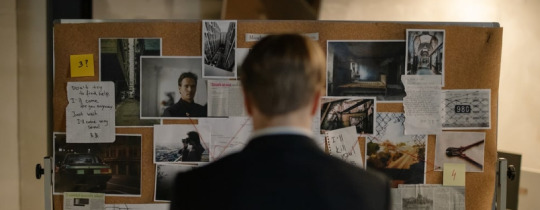
That's the advantage "showing" has over "telling."
The writer may want the reader to know a particular thing, may want to tell them a fact, may want to just copy-paste that detail from their outline into the prose and be done with it. They want to simply tell the reader the thing they want the reader to know.
But if they can show the reader something, and let them draw their own conclusions... that's a lot closer to how their brain works in real life. We experience things in the real world, sense things, see things... process what we've experienced, internalise what's true and what's not... and conclude things from that experience.
If we give the reader the chance to do the same thing while reading our stories, they will experience those stories. They will feel immersed in our world, as if they really saw and experienced those things themselves--because we're getting their brains to work the same way it would if it wa all real.
This is what immersion is all about. Making it feel like they are in the scene with the characters, witnessing everything go down!

On top of that, if we're using a viewpoint character, we're experiencing what they are experiencing. They are seeing "Diamonds sparkled about her neck and hands, and a long faux-fur coat draped over her shoulders." And we are seeing it. They are experiencing the world around them, and we're experiencing it with them.
We're relating to the character by having the same experience they are having! We're simulating how they think. We're seeing them like us: a real human being. (Or non-human being at least.)
So it immerses further, by allowing us to identify with the viewpoint character at a deeper level.
Does this mean everything has to happen on-screen?
Does everything have to witnessed by the viewpoint character and the reader for it to be part of the story? No.
"The Princess gave birth to a son!" the maid cried.
This is dialogue. But... isn't that telling? Shouldn't we write the birth itself into the story, to show that to the reader?
Not necessarily. If the viewpoint character isn't the doctor or the prince or something, it could be highly inappropriate for him to pop his head into the room while the Princess is giving birth, just so the reader can look over his shoulder!
It's perfectly reasonable that a viewpoint character would find things out by being told verbally, or by a written note, or whatever else makes sense--as opposed to witnessing everything to do with the story.
You couldn't have them witness the birth/creation of every character they meet just to accept that they exist, after all. And if they live in the US, it's not necessarily going to be feasible to fly them over to London to see those aliens and then back again so the rest of the story can play out.
This isn't about making everything happen in front of the reader. It's about focusing on the story, showing the experience of the viewpoint character (or if there's an omniscient narrator, what they "experience"). As opposed to telling the reader about the story in a summary.

Dialogue--even exposition like "The Princess gave birth to a son!"--is literally what happened. The maid came running in, and shouted those words, and the viewpoint character heard it. We are being shown what happened in the story.
Compare this to the writer telling the reader. That wouldn't be part of the story. It would be more like "Hey, GRRM here. Princess gave birth--just thought I'd let you know. Anyway, back to blood, grit, and drama."
The story is on hold while the writer tells us about the story. Definitely not as immersive as a character within the story telling another character within the story and the reader just overhearing it.
This is how to make exposition more immersive and enjoyable to read: have the reader overhear, observe, and pick up on things almost "by accident." The key there is to orchestrate those accidents.

There are many ways of getting information to the reader under the guise of it all happening naturally as the story unfolds. Even putting things straight into the narration, but dressing it up as the thoughts of the viewpoint character... as prompted by something they saw or experienced.
The below includes a narrated thought, for example.
I fell to my knees, tears in my eyes. It was a miracle!
This is what the viewpoint character thought. That happened. It is part of the story.
So you can keep things in the realm of the story, even when you're pretty directly feeding them what you want them to know. You can "tell" them without telling them--without them realising it.
Now, is there no excuse for ever outright telling the reader something? Is telling banned?
Not quite.
For the above reasons, it's generally preferable to show things and let the reader experience them most of the time. And to find excuses for them to experience things. But that's not always possible.
And for a particular section it may not be your intention for it to be immersive anyway, so do whatever feels right. The important thing is, understand that "showing" is a thing you can do. It's up to you to figure out how you want to use that understanding.

So what does "Show, Don't Tell" mean?
What is "telling"? The reader learning things by the narrator telling them what they want them to conclude.
What is "showing"? The reader learning things by experiencing the story and drawing their own conclusions.
That's the sweet spot. Keep the reader "in the pocket," keep them immersed and in the flow of seeing the story unfold, and let them figure stuff out themselves, like grown-ups.
You might say it this way:
Writers, show readers the story. Don't tell them about the story.
Instead of someone giving you a summary of "this really cool movie I saw over summer break. And then this happened, and then that happened, and [explosion noise] woohoo!" ...Just let them watch the movie!
Aren't they just the wrong words, then?
Some choose to rewrite the phrase using different words. Which is fine, if it helps them remember what it means. But I think the original words work just fine, too.
The problem is, people assume certain definitions. But there are other perfectly fine definitions we use in everyday speech too. If you reach for "show: to present an image," that takes a bit of mind-bending to get it to fit. But if you asked someone to "show me how to make a cup of tea," you'd expect them to demonstrate, to make the tea in front of you, in a way you can learn from.
And "tell me how to make a cup of tea" would probably get you a list of instructions with no demonstration. An explanation of how to carry out the task. That could be given as text on a piece of paper, or said out loud... that doesn't matter to being told how to do it.
A common reformulation of the phrase is "demonstrate, don't explain." Or "illustrate, don't summarise."
But, as "tell" can mean "communicate information," it's a synonym for those words anyway. And "show" can mean "allow (a quality or emotion) to be perceived; demonstrate or prove," so that's a synonym as well.

So what's the point of "Show, don't tell"?
"Show, Don't Tell" is indicating a direction to head towards if you want the story to be more engaging, and immersive. It reminds us:
Being told a room has no oxygen in it is less visceral than seeing a human being in that room struggling to breathe. "The eiffel tower is 330 metres tall" gets a less emotional reaction than standing beneath it and looking up.
It lets new writers know that it's actually possible to show things to the reader instead of just telling them "She looked rich."
Some writers don't know that they can show things, that showing something can teach the reader what they need to know just as well as telling them. But also be part of the story and enjoyable to read.
"Show, Don't Tell" is a valuable lesson to learn, and to teach others. Just remember to teach it by showing examples, not just telling them the phrase and leaving them to it.
10 notes
·
View notes
Text
To Filler or not to Filler
Some people say filler is bad in a story, others say it's fine... still others say it's important to include, to have a well-rounded story! Are they even talking about the same thing?
What is filler, anyway?

Let's tackle that first; define our terms.
Think about what the word "filler" means in other places. Filler is used to fill a hole in a wall so the cracks don't show. Filler is foam padding in a box so the item being shipped doesn't get damaged. In speaking people use um, er, and "like" to fill time while they figure out what they want to say--that's called "filler" as well.
Filler is something used to fill gaps, with no meaning or use beyond that. Something that is not necessary beyond simply filling something.
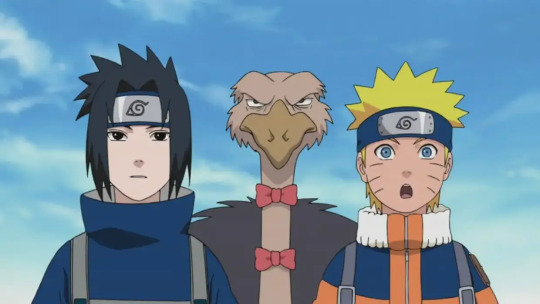
So what does this mean in storytelling terms?
This term is often used referring to serial TV shows (long stories told over multiple episodes, as opposed to "episodic" TV shows where each episode is a self-contained story).
The example that comes to my mind is Naruto: a show featuring long stories told step by step in 23 minute episodes. But from time to time, when the animators are behind the airing schedule a self-contained episode is aired that has nothing to do with the story, progresses nothing, explains nothing, and by the end of it nothing has changed. You could skip such episodes and not have missed anything.
Why did that episode exist? Purely to play out time. They've got to fill 23 minutes every week. So it doesn't matter what's there, all that matters is that it is there. Like filler, the only reason it exists is to be there, to fill something.
Now the question is...
Is "filler" ever needed for novels?
By definition, "filler" does nothing. It does not make your story better. It does not bring you closer to the characters. It does not set the tone. If it did any of those things, it wouldn't be "filler"!
So when would you want a load of words to be in your story that does nothing but use up pages? Never. Not for a regular book or short story, at least.
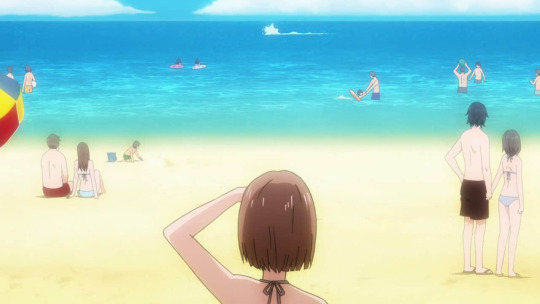
So... why do some say "filler" is good in some circumstances?
I suspect it's because they're not talking about filler. They're talking about something different.
Another anime trope is the "beach episode," where the cast take a break from the story and just go to the beach and hang out. Nothing of note happens at the beach. The characters don't grow, we don't learn anything new, and they all go home ready for the story to continue in the next episode.
In fact, such episodes can just pop up out of nowhere. It makes no sense that they could actually go to the beach and hang out in that moment, but they just wanted to throw in a beach episode, so a beach episode just... happened.
Even so, episodes like this are enjoyed by the fans for several reasons. One reason is, the fans like the characters and simply enjoy their banter and shenanigans even if it's nothing to do with the story. (Another being they get to see anime characters less-than-clothed.)
That kind of episode is filler, because it does nothing beyond use up air time. But it's still enjoyable because we get to hang with the characters without the drama of the story getting in the way. So it's understandable that some conflate the two, thinking that "filler" must mean characters hanging out, or the scene isn't action packed, or something like that.
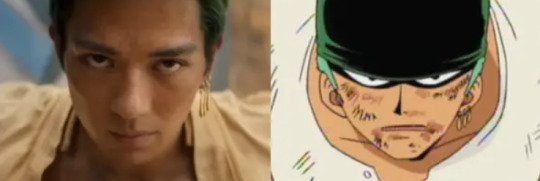
But that isn't actually true.
Filler episodes can have just as much action and stuff going on and still not impact the story, and still not have any time to hang out with the characters. So filler doesn't mean getting to know the characters.
And hanging-out-with-the-characters episodes can show new things about the characters which will be important later, or simply intensify the drama that happens later in the story. So such episodes by definition are not filler.
In fact, a character-hangout can only be a "filler" if it doesn't show anything new about the characters; if it doesn't show or change the relationships between characters. The moment it does anything useful like that, it stops being filler and becomes just a normal scene that still adds to the story that happens to be low-intensity.
Even in storytelling, "filler" doesn't mean a scene with no plot progression or low-stakes or low-impact or low-action. It means it has zero impact beyond that section of any sort. Low-stakes scenes are exactly the kinds of scenes where the characters can interact, where the reader can get to know them, where the background of the world can be filled in.
People are right--those are good scenes to have in your story. And varying the intensity of scenes so that some are big and some are small is what pacing is all about! But the fact they're doing something for the story means it is not filler. It's simply a low-intensity scene.
So feel free to have low-intensity scenes in your stories. But you never need to add filler.
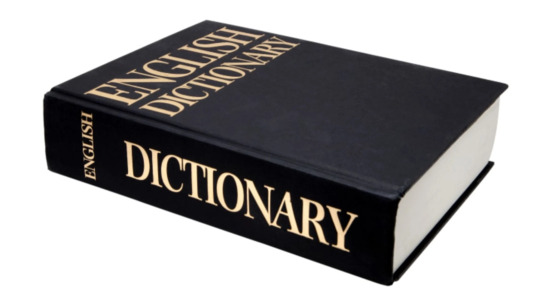
Oh wow, so all we've covered so far is what "filler" means in the first place. But now that we understand what we're talking about...
How is this useful?
There are two main things to take away from this discussion. The first is what "filler" means: zero impact. No change if it's removed entirely.
The second is that there's more that a scene can add to a story than simply plot progression. Character development, character change, worldbuilding... all those kinds of things add to the reader's experience of the story as a whole, even if those ways are subtle or the reader may not realise why it's included.
To say that such things are just "filler" discounts them as meaningless fluff you don't need to put any thought into. Or, it raises the idea of "filler" to something that really enhances any story--which it, by definition does not do.
Unless you have a deadline of releasing a new scene every week and you're behind on figuring out the next non-filler story beat, we don't need to write filler at all. In which case, to seek to add filler is to purposefully pad out the word count of your story with nothing--lowering the overall impact of the story itself.

What if you already have a scene that feels like filler?
Of course, you can simply remove it and suffer little effect on the rest fo the story.
There are times when a scene "feels like filler" to a reader, even if it has elements that do add to the story. Just remember what filler means: zero impact. The less apparent impact a scene has on anything, the closer to pure "filler" it is.
So, try adding more complexity to it. Doesn't have to push the plot forward or have action in it, but the key part is to make it feel like there's a point in reading that section. It might even be a case of making what's there stand out even more, make it more dramatic, something like that.

What if you're struggling to write a scene?
On the other hand, I sometimes see writers asking for help because they're struggling trying to write a filler scene. Or there's a scene they want to have in the story but they're getting blocked trying to write it.
They're struggling because it's a filler scene. If they don't know that, there's something in the back of their mind that senses it. And if they do know it's a filler scene... they know it's pointless even writing it.
In which case, if you still want that scene to be there, the key is to make it not filler. Or... less close to having zero impact. Come up with a reason why it has to be there--what part of the later story does it make work? What dramatic moment does it intensify because this moment happened?
Now you've got a solid reason for writing the scene, it should be a lot easier to get yourself to write it!
7 notes
·
View notes
Text
Using Other Languages in Prose
When a character speaks words from another language, it can be difficult to know how to represent that in the prose. Let's look at various ways of handling this.
The first thing is to figure out what language the narrator is theoretically speaking in. Say for example the book is written in English. The narrator could be a Chinese person, who only speaks Chinese. So then the conceit is that the entire book has been "translated" into English, so that the English reader can understand it.

If then a character in that story speaks Chinese, that too would be "translated" in the same way and end up as English text. Because that's how everything else Chinese is being handled within the book.
Now, what happens if a character speaks a language the narrator doesn't understand? How should that be handled?
Now a Spanish character appears and speaks in their native tongue. This is different from the language the narrator speaks, so it shouldn't simply be translated.
Ana waved and spoke excitedly in a foreign language, presumably Spanish.
You could write it like this, with the narrator not even quoting what was said, because they don't even know how to parse out the words.
Correct (and incorrect?) translations provided by Google Translate. 😅
"¡Hola!" she called across the airport. "¡Es un placer conocerte finalmente!"
Or you could quote what was said entirely. If the language isn't the same as the translated language--in this case English--then it will still come across as being a different language.
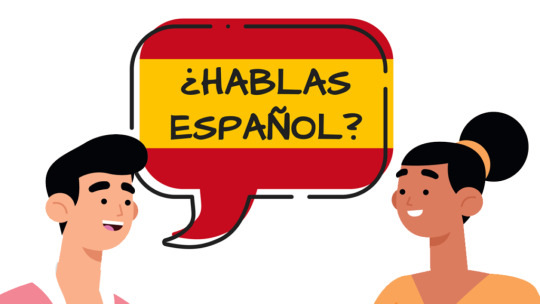
In this case English and Spanish both use the Latin alphabet, so the reader can have some sense of what the dialogue sounds like, even if they don't understand what it means. They may even be able to guess at what some of it means, if there are words that are similar in their language.
If the language uses different characters--for example Japanese vs English--you could use the regular Japanese here.
"あなたの母はどこですか?" Hana said.
Though unless the reader can read that language, they won't be able to "hear" what the character says. But there are ways of writing that can still be phonetically sounded out by the reader, even if they don't understand the language.
For example, Japanese has "hiragana" and "katakana" characters which represent sounds, and can be used to sound out English words for Japanese readers. And we can use something called "romaji" to sound out Japanese words for English readers.
"Anata no haha wa dokodesu ka?" Hana said.

You may need to do something similar for things like complex names whose pronunciation is not easy to figure out from the spelling.
She laughed. "No no, my name is Siobhan. Say it with me--Shiv... awn." Greg did his best to say it back to her. Siobhan shrugged and clapped him on the shoulder. "Close enough I guess... Graaaig!" she said, saying his name strangely in jest.
Something else to remember is, if the reader can read that language themselves, they won't have the feeling of being unable to understand what was said, as the narrator or viewpoint character does.
So if you don't want to the reader to be able to understand the dialogue at all, just narrate that another language was spoken as before.
Another caveat is, if that other language is English--or whatever the book's language is for the reader--this wouldn't work at all. It would be assumed to spoken in Chinese, the same as everything else. In which case, it may be wiser to not quote the speech, and just narrate that they said something in another language.
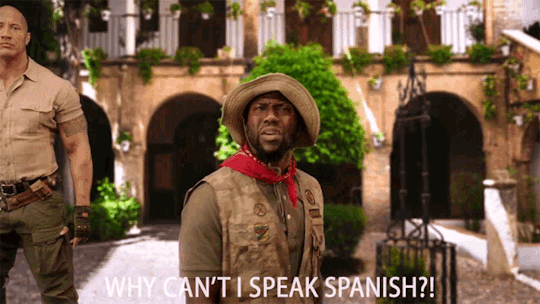
If the speaker uses a mixture of a non-understood language and an understood language, you could separate them like this.
Shi looked bewildered. "I'm sorry, I don't speak Spanish." "Oh lo siento mucho..." she said. "I've been practising my Mandarin, and then forgot to use it! How are you, Shi?"
Mark the other language using italics, for example. Or perhaps put the dialogue inside brackets?
Though, this would probably get quite confusing if English was used as this other language. Because you've got the "translated" book English, next to the not-translated English that the viewpoint character doesn't understand but is just in italics for some reason.
Not really sure what you could do in this case, but hopefully you'll be able to avoid such a situation in your writing? 😅
This is especially useful when a simple word is thrown in from their mother tongue.
"How long has it been, mi amigo?" Ana said, throwing her arms around him.
Here, it doesn't matter too much if the reader does or does not understand the Spanish--the main meaning of the dialogue is written in English. As in, the character said it in Chinese, which was then "translated" by the narrator for the benefit of the reader.
It can be tricky to talk about this stuff clearly, but when you read it in a book it can be fairly intuitive if done well--honest! 😅
Now what if the viewpoint character--Shi in this case--actually understands Spanish? How could you convey that?
Well it would be very confusing if it was simply "translated" by the book without comment. So what else could we do to indicate it's being spoken in a different language but Shi understands what was meant?

Let's rewrite an earlier example:
"¡Hola!" she called across the airport. "¡Es un placer conocerte finalmente!" (It's a pleasure to finally meet you!)
We could simply give the translation after the dialogue, as if the viewpoint character is adding an editorial note to help the reader out. Then we can mark that in some way--with brackets, or italics. Almost like having subtitles in a film!
However you do this, think about it like you're teaching the reader the rules of how your prose works. "Brackets means the translation of a piece of dialogue." If it's clear enough, they'll catch on pretty quick, and then follow along just fine. But if you use brackets for one thing, just be careful not to use it for other things as well or the rule won't be clear in their minds and intuitive.
In some situations you might even get away with showing something that hints at what was meant--the viewpoint character's thoughts, or something else.
"¡Hola!" she called across the airport. "¡Es un placer conocerte finalmente!" "Nice to finally meet you too!" Shi replied in Chinese with a grin. Ana laughed. "Oh lo siento mucho... I've been practising my Mandarin, and then forgot to use it! How are you, Shi?"
The fact he responded that way indicates that he understands what was said, and that Ana said something similar to "Nice to finally meet you."
The reader can pick up on things like that. But even if they don't, the meaning of what she said isn't vital to the story or anything, so that's probably fine.

This could be done in a different way though. You could simply outright say that the character is speaking in a different language.
"Hello!" she called across the airport, in Spanish. "It's lovely to finally meet you!"
So here the narrator is translating from this new language.
Characters could even be conducting a whole conversation in the other language. But you probably don't want to say over and over again "She said this in Spanish, then he said that in Spanish..."
Shi shifted to Spanish too. He'd been practising, and looked forward to speaking to Ana in her own tongue! "He- Hello? Ana," he said, sheepishly. Ana beamed at him. Shi chuckled, and muddled through another sentence. "My... name is... Shi!"
You could have whole scenes where everyone is mainly speaking Spanish, using this method. Even whole chapters, perhaps! Just remember to let the reader know if you go back into Chinese or any other language. You may want to give them a little reminder here and there too, of what mode they're currently in so they don't get confused.
2 notes
·
View notes
Text
P.L.U.G.: A Short Film Rewrite
Written based on a sci-fi short film by David Levy, back in 2016. It also helped me develop my ability to write action scenes, similar to my other #rewrite. It was fun to try writing the story in my own style, tweaking things, adding details and background where necessary for the written form. [source]
P.L.U.G. —Political Logistic Unifying Genome.
A soft beep. A second. Jessie stirred. A third. She groaned, rolling onto her front, away from the sound. A fourth. “Leave me alone, Mum,” she mumbled, still half-asleep.
Could she be back? Jessie bolted upright. “Mum!” she cried.
But Mum wasn’t here. She’d never see her face again. She was gone—just like Dad, just like Grandpa, just like the rest of the whole damned human race.
She winced at the harsh desert sun.
A fifth. The detector!
She looked to her left and started rummaging in the sand for the device. It continued its beep, its warning, its exultation in finally finding something. She picked it up and held the lens to her face, peering through the display. But it was dark, and blurry, sparks of light just visible as they ricocheted about the thin layer of smart glass.
Tapping a button on the side of her face mask, her vision shifted. Molecules in the mask’s lenses rearranged themselves until they let in the full light. It was blinding, but needs must.
Jessie held up the device once more and stared through the squat tube at the lens at the other end. The readout showed a life signature had been found just a few dozen yards to the south-east. Finally, a sign of life! It worked!
She slotted the concussive shells back into her pack and stood, sand falling from her in sheets. She wheeled on the spot, eyes wide, glancing up now and then to see if she could confirm what the hunk of metal was telling her. There! A white-hot blob showed on the glass. She strode towards it, pushing through drifts of sand and heading up a nearby dune.
It wasn’t heat she was looking for; there was more than enough of that out here, in the naked sun. She hadn’t figured out exactly how the device worked. Old 989 still didn’t believe the thing would even work. But she knew from some of her earliest memories of moving across the country that before the end—even before PLUG—there had been a way to differentiate human from machine, to detect life through matter. Her friend wouldn’t have got within 50 feet of a gate, back then. Now there weren’t any gates left.
The thing was a speck in the planet-wide desert, but plain as the antenna on a walking hotspot. Purest black on white sand. As she neared, she saw it scuttle away from her. An alien, insectoid thing the size of her palm.
She knelt in front of it, pulling out a clear container from the bag slung over her shoulder. It turned to face her. It bore two small pincers on its forelimbs, and hung its spiked tail up and over its body towards her. Was this creature always a part of Earth, or had it grown since they left PLUG in charge?
Holding the jar at arm’s length, she scooped it up, taking a handful of sand with it. The mess slipped to the bottom of the container as she put the lid on the top and pressed it down firmly, sealing it tight. She didn’t want whatever it was escaping and nibbling on her in the middle of the night.
Jessie held it in front of her, the creature clicking and squirming, angry at its detainment. It was trapped. All alone. It glared out at the wider universe, and came to know it would never escape its new home.
She sighed, and placed the bottle in the sack. She had to show 989.
#
The jagged metal jaws closed behind her, sunlight being sliced away from the room until only the flickering overhead fluorescents remained. She ambled forward, pulling the mask down round her neck and shoving the hood back.
Her long, blonde hair tumbled from the coat and caught on the mask. She pulled at the strands, freeing them from its grasp, and looked over into the depths of the bar.
A rainbow array of tiny LEDs sparked and bounced off the chairs and tables and the head panels of the robots. In the back sat a tall, chunky metalhead. Red stripes painted the back of its neck, slipping up the fins on its smooth, metal head and running down its shoulders. 989.
A smile grew on her face. He’d never believe it! She waved, with a smirk, and stepped forward.
A hand grabbed her arm and pulled her back.
“What is your reference number?” a voice growled. The bot was angular—tall, triangular ports stuck proudly from the side of its head. Blue panels presenting menacing, jagged lines down the face that wasn’t there.
None of them had faces. All they needed were sensors, motors, and a CPU. The hardware wasn’t designed to put humans at ease. They were designed to get the job done. Then designed to kill.
She pulled her arm from its grip. “Let go of me, dumbass,” she said, dismissively. The bot dropped and wandered off to the back of the room.
Once the war ended, the majority of military models became impotent. A lot of them still stood in the corners of warehouses, awaiting instructions. Those that still had some agency—ones originally designed as aides or bodyguards that were designed to interact with people—became impotent to humans. Well, to her at least. They were just puppy dogs, now.
As she passed through the bar, some bots nodded, a mechanical burble buzzing from their speakers. Others ignored her and focussed on porting their Juice.
She gazed over at the barman, a would-be maintenance bot with 4 bright beams on the front of its head. She approached, and leaned up against the steel plating that formed the counter top.
“What’s wrong with your doorman?” she asked.
It looked up from rearranging the Juiceboxes for the umpteenth time. “It’s touchy,” it said. It sounded like a shaver running out of power. Ironically. “We’ve had some attacks. Anomalies.”
“Bad machines, huh?” Some military models—even a few public-sector bots—went crazy after the war ended.
“There are no bad machines,” it said. “Just bad programming.”
She laughed under her breath. “Yeah. Right.” It was rare—they moved around a lot—but they performed raids on bars like this one to keep themselves going. These maintenance ports would serve anyone that walked in through the front door with a modicum of scrap, but crazy be crazy. She just hoped she’d never come across them. They’d have the scanners too, and may not take too kindly to finding a real-live human wandering around on their planet. “Speaking of bad programming…”
She slipped away from the bar and strode deeper into the room. Marker sat oblivious, welding a panel, flashes of vibrant yellow strobing on the wall beyond. He wore an old leather jacket. He was one of those.
Most knew PLUG reserved that privilege of sentience—of true autonomy—for itself. But as she got to know Nine, she doubted the legend of PLUG’s all-knowing, all-powerful, all-unique-as-a-snowflake persona.
Jessie tapped him on the shoulder. “What’s up, tin man?” He turned to look at her, its aerodynamic fins flicking by her head, central white and red leds dimming so as to not blind her delicate optical sensors. “Am I late?” she asked.
He turned back to the panel and readied for another blast of plasma. “Of course you are.” His voice wasn’t loud and obnoxious like the others. It was softer, more… human, somehow.
She hadn’t figured out what model he was yet. From the red dot on his forehead he could’ve been a Marker. But he was always swapping panels and grafting better servos onto himself, so the head panels could’ve been from anywhere. The other seemed squeamish of such “perverted modifications,” but her 989 was pragmatic. A realist.
As she sat down he discarded the torch in favour of a small circular saw, and resumed work. She flipped open her bag and pulled out the jar. The bug raised its claws as it was brought out into the light, wary of what day-ruining nonsense would come for him next.
She plonked it on the steel slab of the table and looked up at Nine, grinning from ear to ear.
He paused, and looked over at the jar, then at Jessie. He picked up it up and brought it closer to the sensing nodes buried beneath tiny holes in his faceplate. He looked back at the girl. The leds flickered as he spoke. “He’ll cook it for you if you ask nicely,” he said, putting it back on the table.
“Not that desperate,” she said, pulling the bag off her shoulder and folding it next to her. “Yet. I found it, Nine! With the mil-spec sensor, it works! It picks up anything living within 200 yards.”
He paused for a moment, glancing between Jessie and the bug.
She shook her head, her smile fading, and pulled the device out of the bag. “You have to try it out.” She handed it to him.
He took it, turning it over in his hand, head cocked as he tried to scan it for an interface. With a laugh, Jessie took his arm and moved it to the grip. “This one’s for humans, man,” she said. She pulled his arm up in front of him, then flicked a switch on the top of the unit. “Point and shoot.”
He waved it about, and it started scanning the area. “It’s not bad,” he said, looking back at her.
Her smile picked up again, then a look of determination. “So can we go looking? Today?”
989 paused once again, then shook his head and put the device down.
“Nine, help me!”
“Jessie, your parents are gone.” His voice was slow and deliberate. “They’ve all gone.” He leaned back in his chair. “Humans messed up the planet and they left.”
“No. Not everyone. I’m still here!”
“Yes. And you’re the exception.”
Jessie’s jaw slackened and eyes dropped. They flitted over the table—to the device, to the jar, to the trapped little animal inside. “Please,” she said, reaching forward and holding his gloved hand. She looked up into his faceplate. “Help me.”
He looked up, back down at the panel. Nine was all she had. She couldn’t do this without him. He looked into her eyes. “Okay. We’re not going to find anything,” he said, waving a pointed finger in her direction, “But we’ll go looking.”
She smiled and took the device back, fiddling with the controls. They were doing it. They were actually doing it!
The doors opened, spraying light across the gloomy hall. A figure stepped in, red lights sparkling about its bulbous head. It waited as the doorman stepped forward and waved its detector over its body, the doors closing behind it. After a moment, the doorman stepped back and the newcomer stepped into the room. It strode to the bar and asked for an Electro.
She hadn’t seen its model before. It almost looked like an old multipurpose attendant unit, but the shape was all wrong.
Jessie shrugged and continued playing with the detector, pointing it round the room at robot after robot, watching the readout struggle to keep up with the motion.
It started to beep.
A green glow spread across the bar as a cylinder of Juice was placed on it. “What have you got for me?” the barman said.
The red robot put something onto the metal counter.
The barman sounded surprised as he inspected the parts. “It’s been a while,” it said. “They don’t build them like these any more.”
“Yeah, they don’t make ‘em like me any more, either,” Red responded. It picked up the liter Juicebox and turned away from the bar. “Too bad.” Its voice was clearer, its range intact. Speakers were the first things to go, but the metalheads weren’t too fussed. All they needed was a clean enough signal to be interpreted by other drones and they could get by okay.
Jessie frowned down at the device, patting it on its side. The beeping stopped. Was there faulty wiring? Was the CPU finally dying? “There’s something messing with it.”
“Atmospheric EM?” 989 asked.
She stood, and held it out, testing the back wall, the chairs. “No, it’s something else.” She wandered through the bar, waving it towards robot after robot, waving it at herself. It all seemed fine, now. Beeping when it should beep, silent when it—
It beeped again, this time aimed out into the room. It was even stronger here, the lens showing a large blob of blurry white. Jessie moved forward, following its lead. She looked up. At a robot sitting behind a table. The one with red LEDs speckling its head. It looked back at her, then grew still.
It didn’t look military. It wasn’t raiding the place. It was just sitting there, quietly locking the green power cell into an alcove on its back. “Excuse me,” she said. “But what are you made of?”
It didn’t respond.
She shrugged and stepped forward, pulling a lighter out from her coat. Flicking out a flame, she started examining the unit closely. It didn’t flinch. A puppy dog, like all of them. Her fingers spidered over carbon fibre plating and thick cables connecting limbs to torso, head to body. She couldn’t see a single thing out of place that could explain the readouts she was getting.
She moved round to its faceplate. Sensors, twin IR blasters, thin speaker grill on the bottom half… The flame guttered. Jessie frowned. The door was closed. There was no ventilation needed for the metalheads. She looked back at the red robot three inches in front of her face, breath caught in her chest.
“Are you—”
A powerful kick to the chest sent Jessie flying back into a storage container propped up against the bar. Chaos flowered in the close confines, robots standing, gunfire ringing out. Metalheads dropped around her as she crawled towards the back of the room.
“Nine!” she called, her voice drowned behind the sound of gunpowder blasts and the clanks of half-ton machines falling to the grating.
The fluorescents switched off. The sound of motors whirred in the background as the hatches and ports sealed. Red flashes transformed the room in a kaleidoscope of light and shadow. He’d taken the power. He was one of the raiders, after all. Was there a military model she wasn’t aware of?
989 stepped towards her. “Jessie!” He looked away from her, back towards the red robot.
It was slaughtering them. It was killing them all. They didn’t have a chance!
She jumped up off the floor, bruised ribs etching hot pain across her belly. “No!” she yelled, grabbing her friend in a bear hug. They couldn’t die. Not when they were so close!
There was a pause. The only sound was her heartbeat in her ears. 989 half-heartedly struggled against her. But the only way he could break through would be to rip her arms away from him. She held fast.
An explosion sounded behind them and a fraction of a second later they were blown back. Nine slammed into the bulkhead with a crunch, and Jessie’s head slammed into his steel chest.
When she opened her bleary eyes, the room was bright again. She winced, holding her head as she turned to look at the room. The bright white light of the sun glinted off of still, metal bodies. Melted circled lines cavities that weren’t there by design.
“Are you okay?” Nine said.
Ignoring him, she stood and walked into the room. She glanced behind the bar. Most of the Juice had been taken. What was left had been shot through, the glowing ooze dripping down aluminium fascias.
“I told you, it’s not safe for you here.”
The sharp smell of burning wires and singed circuits filled her nose. All this death. What was it for? And if the thing truly was alive—maybe human—what would it need with all that power?
She frowned, and started walking. Either way, if the thing was human, she had to know. It couldn’t get away from her. Not now.
“I’m driving,” she said, and stepped out into the light.
#
Plumes of dust billowed from the back wheels of the buggy as the loud petrol engine sang out across the desert. The mask wasn’t great for visibility, but Jessie needed it in the naked sun. There was no atmosphere to protect them, now.
“Where are they?” she yelled, her voice muffled through the mask and the wind beyond.
989, sitting to her right in the passenger seat, continued scanning the horizon with the device. “Are you sure this thing is working?” he said.
They bounced over a pothole. She tightened her grip on the wheel and pushed the pedal to the floor. “It’s fine. I need the heading or he’ll get away from me.”
He stared at her a moment, then looked back at the scanner. “Okay, okay,” he mumbled. He twisted it round to get a better look at the controls. “Maybe if I—” The device beeped. Nine thrust out a finger to the left. “There!”
Jessie pulled hard on the wheel. Her body pulled to the right, the harness digging into her ribs, blooming the pain once more. Nine righted himself perfectly, as always. He didn’t even need a harness to keep him in the seat—and if they crashed he’d just shake it off anyway.
They rounded another port into a ravine, cliffs guarding either side. Its jagged sheets of metal jutted out of the sand and rock at odd angles. There were hundreds, thousands, of the things perforating the Earth, now.
The machine-made buildings didn’t have any sense of aesthetic the early models had. Once PLUG started making its own soldiers all but necessity and optimisation went out the window. Seemed this port was dead too though. No lights, all locked up. Just what did they need the power cells for?
The sound of a second combustion engine reverberated about the rocky cliffs. Just a couple hundred feet away, a motorcycle powered away from them. A green glow stabbed through a large sack that was pinned to the back of the seat. And the rider was a metalhead, its face glowing red as it glanced over its shoulder. But then, why would a robot need to turn its head to look behind it if it had sensors?
A small, dark object shot into the air from the bike towards them. A silent blip blip blip flashed as it turned in the air. A pipe bomb!
“Look out!” Nine shouted.
Jessie pulled right, swerving to avoid the explosive. It went off as they passed, sending rubble and sand high into the air. As they pushed through the other side of the cloud she swerved left, just scraping one of the cliffs. “That was close,” she muttered.
“What was?” he yelled.
“Nothing!” she yelled back. Perfect hearing could be pretty annoying at times.
The cliffs finally gave way and the bike made a sudden swerve to the left. It hit a long piece of plate steel and launched into the air.
She pulled the buggy round, trying to follow the bike’s agile movements. But the vehicle lost traction in the loose sand, skidding sideways and sending a cloud of dust into the air. Feeling control slip out of her grasp she cut the throttle and let the buggy come to a stop.
Jessie slammed her hands into the wheel, swearing.
989 stood up, his head poking through the roof, followed the bike as the assailant rode away. “It’s okay. We can—” He looked down. “Woah! Now that was close.”
As the smoke cleared Jessie saw a wide, gaping crevice in the ground just a few feet away from the back tires. “I’m… I’m sorry,” she said, tears welling up. Why didn’t she just let him drive? “I didn’t—”
“Oh just shut up and drive, would you?” Nine said, slipping back down into his seat. The suspension creaked with the heavy weight change.
She sniffed and wiggled her fingers under her mask, wiping at her eyes. “But we’ll never fit on the—”
“Just go around. I think I know where he’s going. Now get going!”
With a smile, she floored the pedal once more, her head snapping back as they zoomed away.
#
The crack in the Earth wasn’t that long, as it turned out. They rounded the end within a minute, and it only took one more to catch up with the fugitive.
It stood next to the bike beneath a tall structure, which was maybe five meters in height. It was a strange, spindly thing, with four legs stabbed straight down into the ground. After a joint, the legs continued in a cross-beam, joining the four corners of a square above. Where the four beams met hung a big, blocky, old-world engine of some kind; some form of unfamiliar tech. The steel was thin—no sign of the usual carbon nanotube alloy that marked all machine structures. If this was the beginnings of some kind of structure, it wouldn’t last long once they put the walls up.
Hearing the buggy hurtle through the cracked stone, it turned, flashing its red LEDs. Shaking its head, he stamped on a small protrusion in the ground and walked towards them. As he moved away the bike started to sink into the ground, as if the sand shifted out of the way, leaving a gaping hole.
A dark steel device glinted in the sun as the robot turned it in his hands, a long, heavy device, not unlike the pipe bomb in design. Another bomb? Jessie pushed harder into the floor, willing the small buggy to go faster.
But Red didn’t throw it. Instead, it hoisted it in front of itself, slammed it into the ground, and walked back towards the structure. She could see now that there was a small light flashing on its top, and a glass-like chamber along its length.
“What the—?”
The explosion was silent, but she felt the blast. A flash of light from the thing’s bulb, and then the engine cut out.
The pedals didn’t respond. The sound of arcing electricity was loud in her ears. She turned and returned the key, but the ignition didn’t even try to start. “Nine, what’s going on?” She glanced up at the machine still walking back to the structure. He was getting away! If he could shift into the sand too, she’d never see him again!
“Nine, what do we do?” Jessie shouted. She turned to look at her friend, but he didn’t respond. She shook him, but all she heard was the clatter of the machine gun as it fell from his hands onto the cracked, desiccated earth. “Nine?”
She turned his head towards her. The LEDs flickered and died as she watched. No. No! She didn’t care about her parents. They abandoned her long ago. When 989 found her, he kept her safe from militaries. He brought her food from old survival bunkers where the food was still flash-frozen from before they all left her. What did she need the humankind for? But now he’d been taken from her, too.
Looking back at the red robot, she scowled. Whoever it was, whatever it was, it didn’t deserve to live. Not when it’d taken everything from her.
Jessie stepped out of the buggy and turned back. She ripped an automatic magnetically attached to the side of the vehicle, and started walking.
She ripped the mask from her face, half-blinded by direct sunlight. “Hey!” she screamed. It ignored her, still walking away. She poked a few buttons on the weapon’s side and hefted it up, aiming towards the creature. “Wait!”
It turned. She fired.
The first spray of bullets popped as it drew a line up one of the structure’s legs.
The robot glanced at the damage, then back at her. It held out a hand for her to stop.
“That important to you?” she yelled, reloading. She pressed another button, shifting it to shotgun mode. The robot’s head drooped and it brought its hand to its face. “Good!”
She hefted the gun once more and trained it on the machine. Her life was over. But not before she finished this.
Red looked up. Its faceplate was missing. But instead of motors and actuators, chips and sensors, there was something pink and fleshy behind that mask. Jessie stopped dead in her tracks, her breath leaving her.
She made unintelligible noises, trying to speak the torrent of thoughts running through her mind. Was it alive? Was it human? She stared at the creature, at its eyes, at its stubble. It had a nose. It had teeth. It… frowned.
The Earth shook. Stumbling back, Jessie fought to stay upright as she saw cracks pop from the ground. A great scraping sound echoed from overhead. She looked up and saw the structure start to move. An earthquake? Would the scaffolding fall?
“Stupid girl,” Red muttered. Its voice was deeper than hers, like the machines themselves, but there was no buzz and crackle of the speaker. It—or he—turned and walked back towards where the motorbike had sank down.
The engine flipped upside down and seemed to open up into something else. The legs transformed too, the horizontal shafts sliding down the verticals until the whole thing was only a couple of meters off the ground. A leg ripped out of the ground and slammed back down to the hard ground. Its other legs followed suit. The engine—or its head, maybe—flashed red, just like the robot. It glared down at her as it spidered across the ground toward her.
Jessie fired once more, watching as what little shot hit the thing glanced harmlessly off its shell. It wasn’t just ordinary steel, then. She threw the gun to the ground, turned, and ran.
The shells! As she stumbled on, she patted down her trousers, searching for the small devices. Bringing one out, she glanced down at it. The bombs were small, but if she was lucky and hit it in a vent, or damaged a processing unit, maybe she’d make it out of this alive.
She turned and threw it wildly, as hard as she could. It hit the creature’s head and detonated in a cloud of fire and smoke. The blast knocked her off balance, and she fell to the dirt. She could hear the thing walk on, barely a hitch in its stride. This was it. First her family, then her other family, and now her. Why did she deserve this?
A shadow crossed her as the machine stopped, perched over her. Motors worked and gears whirred as it readied to strike. She kept her eyes on the ground. She’d stared at her own oblivion for a decade now. She couldn’t bare to watch as it finally caught up with her.
An explosion cracked the sky. Orange bloomed over the sands as heat flashed across her back. And death didn’t come.
“Jessie!” a soft, mechanical voice said.
She started to push herself off the ground, staring up at him in a daze. Nine? But he was dead.
“Get down!” he barked, raising a long, heavy railgun at the beast once more.
She dropped to the dirt and covered the back of her head as the second orange flash hit. The sound of steel ripping and panels warping screamed into the desert. The hunking metal monster crashed to the ground behind her with an almighty crunch. But she couldn’t look. It was her imagination. She’d finally snapped. After all these years, she finally lost it!
“Jessie, you okay?” That same haunting voice. “Come on. Get up.” He couldn’t make her. Tears started to cloud her vision. He couldn’t make her anymore.
But then something strange happened. Something touched her. Something hard, but padded like a leather glove. Padded like the gloves Nine got so he could hug her without leaving bruises in her skin. She was picked up from the ground, and put on her feet, in a whirl of motion. He never did get the hang of subtlety.
Jessie looked up into those flickering white and red LEDs. “Are you okay?” he said. She stared at him for a moment. Same fins, same smooth design… same leather jacket. She wrapped her arms around him in that same desperate bear hug she always did. Maybe she was crazy. Or maybe her life wasn’t over after all.
“Jessie.”
“I thought you were dead,” she sobbed.
“ Hold on.”
She frowned and hugged him tighter. “I’m so—”
“Look!” he shouted.
Reluctantly, she relaxed her grip and turned to look at the monster. “It’s dead. You saved—”
He pointed. “No, look!”
Her eyes moved beyond the wreckage and landed on square metal sheet in the ground, not far from where the bike had sunk underground. But no, it wasn’t scrap. It was a door. A hatch. No, it was a lift.
Jessie let go of 989 and stepped towards it, shielding her eyes from the harsh sun. “I thought we were done.”
Nine strode past her. “Not today.”
She followed as he picked a path through the wreckage. The smell of burning oil and melting metals seeped into the hot air.
As they neared the site, something caught the light—a bulge in the Earth. She knelt down in front of it and started wiping the dust off its surface. It was cool to the touch, though not as cold as glass. But as she dusted off the rubble she saw darkness beyond. It was a half-spherical window, jutting out of the ground, letting in light like in the bunkers she’d wandered through as a kid. But what was it letting light into?
“Jessie, be careful.”
“On it,” she said. She leaned forward, hands on either side of the window, peering in through the transparent material. It wasn’t just dark in there. There were lights, a mass of thin cables, meter-wide pipes, gridded walkways, tunnels… “How long has this been here?” she muttered.
A gunshot rang out. She looked up to see Nine spin through the air, falling in slow-mo to the ground. “No!” Not again. “Don’t—!”This was not happening again!
She stood and whirled around to see the man from before, gun trained on the robot.
“What are you doing?” she shouted, stepping in front of her friend.
He stepped gingerly towards her, his gun still at the ready. His robotic armour seemed grotesque now, perverse.
“We—” she stuttered. What could she say? “I was just looking for… someone.”
“Well you’ve found us,” the man said, craning his neck to look round. “But that thing ain’t gonna talk about it. Get back!”
“No. No!”
989 touched her shoulder. “Jessie, there’s plenty more like me. There’s no one like you.”
She ignored him, staring hotly at the man in front of her. “He’s… He’s all I’ve got.”
His gun lowered a little. “That tin man?” he said with a snarl. “Don’t make me sick!” His expression softened. “What have they been pumping you with? Sister, your people are people.”
She stood her ground. “The ‘people’ all left.”
He frowned.
She continued. “They left me. They messed up the Earth and then they left it for the machines to clear up.”
His face broke into a smile. “My… They messed things up alright, but they didn’t just bug out!” He looked over her right shoulder, at Nine. “Go on, tin can. You tell her.”
Jessie worked her fist open and closed. “Tell me what?”
“Tell her!” the man yelled.
Nine stepped forward, and turned to face her. “Humans were the problem. PLUG had to make them to go.” His head dropped. “They were killing the planet, Jessie. There was no choice—”
“Wait.” She looked at the man, then back at Nine. Her friend. Her protector who would never lie… “You made them leave?” He looked away. “Everyone?”
“Almost everyone.”
She stepped back from him. Her knuckles were white, now. “Why keep me?”
“The ships had already gone,” he said. “It was the right thing to do.”
She looked away, stared out at the desert. It wasn’t his fault. If PLUG wasn’t the saviour they said it was, it would never have sent that order. Even the vast machine workforce weren’t to blame. Nine was sentient before he found her; he made his own choices.
“Jealous?” the man said. He raised his weapon once more, readying to fire on 989.
She ran back to the robot, arm reaching toward the man. “No!” she said. “Not like this!”
The man’s voice was harsh, but pleading. “He’s not going back with what he’s seen.”
Nine started tugging at her bag, but she just stared into the man’s eyes. She wasn’t going to move.
His tone shifted to determination. “I’ve gotta tell you, no metalhead is worth his hide to me.” He reloaded his weapon, a thousand microshots slotting into the barrel.
Still she didn’t move.
He waited a few seconds, before swearing. “Bad choice,” he said, hefting the gun. “Okay, you’re done. We’re exposed. Screw you both.”
“No!” Nine shouted. His arm shot out in front of Jessie. Something small flew out of his hand.
The man screamed as it hit him square in the face. Frantically, he brushed at the thing until it fell to the ground. He stamped on it once, twice, then stepped back, feeling at his face through gloved hands.
Jessie looked down. A big bug lay dead at the man’s feet, its long, barbed tail still and broken. The man yelled, terrified of something.
“What…” she mumbled. He fell to the ground, screaming in pain. Suddenly he grew quiet, curling up in a rictus ball. “What the hell was that?”
“That bug you found. It was a scorpion,” Nine said. “Its venom can kill a human in a few hours.”
She turned to him. “What?”
He walked past her towards the man, still writhing silently on the floor. “Want to know why I told you not to go looking for weird creatures in the desert?” he stopped over the man and stared down. Shaking his head, 989 raised his leg. “Just ask him.”
“Don’t,” she said, touching the robot’s shoulder. He stood at ease, and looked back at her. She looked around again, out at the desert, over the window, back at the hatch. After a moment’s thought, she turned back to her friend. “Carry him,” she said. “We’re going in.”
The robot picked up the prone body of the only other human on the planet—as far as she could tell—and slung the man over his back.
They walked back to the lift hatch. She turned one last time at the world she’d been trapped in for so many years. At the life of loneliness, of abandonment. She’d find PLUG. She’d bring humans back to their home planet. She’d find her parents.
“You may find no answers down there, Jessie,” Nine said, stepping up next to her. “You know that, right?”
She stomped on the small glowing button embedded in the lift floor and felt the steel start to descend. “But it’s a good place to start.”
0 notes
Text
Solo-Writer Psychosis
Writing is almost always a solo activity. You write alone, day in, day out. You're in a little submarine peddling away, and well done for putting the work in!

But if you've never used the periscope, how will you know what direction you're peddling in? All you have to go on is your own guesswork.
You start to worry... are you right? You think you're making progress, but something feels off. What are the currents and waves doing to your course? What if you're going the wrong direction? Are there rocks ahead? Maybe you should ABANDON SHIP! 😱
It can feel like you're going insane, spiralling out of control, not knowing which way is up! What puts you in that dark place? And how do you get out?...
Keeping your head down and writing is admirable. But you're essentially working in a vacuum.

If you're an experienced writer you may have the confidence to blast through an entire first draft without coming up for air, without once having a moment of self-doubt.
If you're not that experienced and self-assured, you might start having doubts, with no way of answering them...
"I've been writing and rewriting the same chapter for what seems like months! How do I know if the story is perfect yet?" "There's something off about my writing, but I don't know what! PLEASE SEND HELP!?!?" "Should I just quit?!"
If you're not careful you can spiral into oblivion, floating about inside your own head, with no way of navigating or knowing which way is up. You can feel trapped in Solo-Writer Psychosis.

You need to check your landmarks. You need to pop your periscope up above the waves to check on where you're headed, where your destination is, where the rocks are, where safe harbour might be. Take stock of your surroundings and adjust course where necessary.
Instead of simply being buffeted by the waves and undercurrents, now you know exactly where you are and where you're going.
How can you do that as a writer?
Get feedback.
Getting feedback on what you've written gives you landmarks as to what is working as intended and what is not. You can adjust course, steering away from effects you don't want your text to have. You can spot new routes you hadn't considered. And you can be confident knowing that other parts of the story are having the effect you want them to have.
You might even get feedback, but don't fully trust it. "It all seems just too positive--are they just scared to tell it how it is?" Even if they aren't scared to give you negative feedback, it's easy to think this way. And so, you've put your periscope up, but don't feel like you gathered any data about real landmarks. So you're still stuck!
This isn't to say you should aim to write in a way that all readers will enjoy. Or that you should appease every piece of feedback you receive. That's not the point at all.

This is your art. You're in control. You set the desired destination, the intended experience you want readers to have. This just lets you steer your way towards it.
Landmarks don't tell you where to go. They tell you where you are and where you're headed. Feedback is simply checking the landmarks to know where your story is so far.
Now how do you feel when you put the periscope back down and carry on peddling? You're a lot more sure of yourself. Even if you need to make corrections to get where you want to go... you're making them. And now you're confident you're heading toward the destination you've set! Ahoy maties! (or something)
I have another article on how to improve as a writer. The feedback sections go over why getting and giving feedback helps you develop your skills, and how to get the most out of the process.
1 note
·
View note
Text
Breaking Paragraphs & Splitting Sentences
a.k.a. "How not to ramble"
When speaking day to day, we don't think about where a sentence begins and ends. Or when a paragraph begins and ends. We don't even put punctuation in!
We can just ramble on and on about whatever's on our mind, like toasters, and walruses, and love, and chicken costumes. About that crazy thing that happened to us last night when you went out for a walk on the beach, and then watched the sunset, and then picked up a beer can, but then you were carrying it for what seemed like hours, searching for a bin to put it in, they should really put more bins on the beach, the place is a mess at the end of every day, what is sand anyway?

A stream of consciousness like that can work in prose... But if you want to make it easy to parse out the story itself, some structure is required to give the reader hints as to how to structure it in their own minds.
How does all that work? And how can you break up sentences and paragraphs in a way that affects your readers the way you want them to?
This isn't a case of making them "the right length" or having "enough" sentences/words so you can move on to the next one.
This is art, baby! And as such there are no easy rules to follow like that. You can do what you want, and go by feel.
Though if you just can't seem to get it right, and need more to go on... this article dives into "what's up with these paragraphs things anyway"? And "how sentence"? So you can build up an intuition for how they work, and how you can use them to affect your readers.
And we'll do so by you reading bits of prose, and watching out for your reactions to them...
You've already read the first example, in fact! What did you think of that stream-of-consciousness paragraph up there? How easy was it to read? Could you pick out a thread of story from it? It was a bit of a mess, right?
It was more difficult to read because its basic structures—paragraphs and sentences—were not used in a way that helps the reader out.

A paragraph keeps going until it ends with a new line, and a new paragraph. That new line is called a "paragraph break." Paragraph breaks are used to break the prose down into chunks the reader can file away into their brains, slotting it into the picture they've got of the story so far.
That doesn't mean they're memorizing all the words of the paragraph, though. They're memorizing a condensed form of what they think the paragraph means. Like a summary.
So what do you think the paragraph above means? When I read it it just comes off as gobbledygook, as rambling "stuff" that doesn't really have any point it's trying to make. And doesn't have any meaning it's trying to get us to file away. It's pretty much impossible to summarise.
This is why we have the term "wall of text." When a piece of text has few structures to chunk up information, it can be daunting to even start reading it.
First, we'd have to chunk it up ourselves--which is just annoying. But also it'll either be rambly nonsense with no real information so we can't understand it well enough to file away... or in theory it could have so much real information all in one go that we'll get overloaded and can't hold onto all of it when we summarise it.

Ever seen a scientific paper like that? They can get away with that because it's meant to be packed with information. And they're largely intended to be read by people who already understand all the terms, so they have a better chance of understanding it in the first place!
But with stories, with prose, the goal is for most people to be able to understand your writing. Not just specialists that already know what you're talking about.
So, we know we need to put in paragraph breaks to "break up that wall." But where? How do you tell what should be grouped up into a paragraph and when it should just keep going?
As with all art stuff, it's more intuition than anything. So as you read the following examples, think about how it "feels like" to read them. Why do they have that effect? And how can we use our understanding of what's going on to our advantage?

Jeff leaped into the air.
A paragraph could be just a single sentence, focused in on a single moment.
Remember, our brain condenses it down into what the point was for that paragraph, like a summary. What would the summary be for this? Probably just "Jeff leaped into the air."
This seems a little pointless to point out... but think about what this is doing for the reader's experience. How much effort do they have to put in to summarising the paragraph? 0%. And how much of the paragraph's text made it into the chunk they filed away? 100%. How many words were lost? None. And how many words had important meaning that you locked in to your brain? All of them.
One action holds all of our attention.
This is why a very short paragraph can have a big impact. In this example, it's probably not worth that impact—unless that leap has a big dramatic meaning.
Perhaps Jeff is leaping down into a gorge to fight a Balrog, sacrificing himself so his friends can escape. This short paragraph by itself holds on that moment in the reader's mind. Lets them ruminate on that moment and all that it means. The implications, the dramatic weight it carries from what came before in the story!
We can use paragraph length to have things stand out in different ways like this. Flip through your favourite novel sometime and look out for the lengths of paragraphs. Why did they choose to make it shorter or longer?
But anyway... this one doesn't have such impact, but it's cool to think about. 😅 It should probably have some more going on in the paragraph.

Jeff leaped into the air. He landed hard on a shipping container, with a clang.
Here, the paragraph as a whole has a little less impact. What happened to the impact of that first sentence? Did it go up or down? The main thrust is "Jeff gets on the shipping container." That's all that will matter for whatever comes next.
So the leap doesn't really matter now. And therefore those words didn't contribute much to the "summary" we automatically formulate in our heads. Instead of all the words being important, only maybe half of them are.
That isn't to say you need to cut out the less important words. It just highlights the extra impact a short paragraph can have with its contents.
If you wanted to, you could try combining sentences.

Jeff leaped into the air and landed hard on a shipping container, with a clang.
Now it feels like one smooth action, a long moment that blends together. That actually feels better to me. Instead of a series of separate sentences, only one of which having any impact on the story that comes after it... it's one sentence that impacts the story as a whole.
Think of it like a comic panel. You can have just 1 thing happening in the panel with extra impact. Or multiple moments of action joined together with motion lines.
Or I prefer thinking of it as an animated gif, joining multiple independent photos--multiple moments in time.
You can't just join everything together into a single sentence though.

Jeff leaped into the air, and landed hard on a shipping container, with a clang, and thought he heard a noise, and ran over to investigate, and said "Who goes there?"
Ick. Right? I mean, you can probably understand what's going on. But it's a bit of a blurry mess.
Why don't run-on sentences like this work, though? Why does it feel rambly even though the paragraph isn't overly long?
Well, what is the point of this sentence? Like we did with paragraphs... think about what the summary is.
Because it's all crammed into one sentence, it's very difficult to summarise. It could be "Jeff gets onto the shipping container." Or "Jeff hears a noise."
If you want to stretch it, you could say "Jeff does some stuff." But if that's all you remember about the sentence, how impactful can that be on the your experience? Little to none. And maybe only a quarter of the words had any impact at all, if we're being generous!
That "with a clang" sensory detail was a nice little tidbit before. Now it gets lost in the noise of actions and dialogue. It kinda feels out of place. There's no longer any room for experiential stuff that grounds the reader in the scene.

So you could cut it all down and remove whole parts of what happened from that sentence. Or you could split the sentence.
Splitting Sentences
How do we do that? First, think about what separate pieces of information we're getting from that sentence. I tend to use slashes for this.
Jeff leaped into the air / and landed hard on a shipping container, with a clang / and thought he heard a noise / and ran over to investigate / and said "Who goes there?"
Now, why is each of them there? What are they contributing to the paragraph? I'll bullet these out so it's easier to label each of them.
Jeff leaped into the air --movement
and landed hard on a shipping container, with a clang --(continues moving) more movement (with sensory detail)
and thought he heard a noise --(stops moving) hears something
and ran over to investigate --movement (because he heard something)
and said "Who goes there?" --dialogue (because he heard something)
Now, you could split each of those parts into their own sentence. But that isn't always necessary. As we saw earlier, the "long moment" of the leap and landing works fine joined up. In terms of the above notes, he moves, then continues moving into the landing. It has one through-line, getting from A to B.
But then Jeff stops moving. That through-line ends, and a new one begins. That makes the perfect opportunity to split the sentence here. The sentence ending hints to the reader's brain that a new through-line is beginning, making it easier to comprehend.
Then he resumes movement, but in a new trajectory--with a new reason, a new goal. It's also implied he stops at wherever he ran to. As this action is caused directly from Jeff hearing something, you could tag it onto that previous part.
And then Jeff speaks. This is separate text that is marked as being different from normal narration. Which is why it should also be its own sentence.
That gives us:
Jeff leaped into the air, and landed hard on a shipping container with a clang. He thought he heard a noise, and ran over to investigate. "Who goes there?" Jeff said.
Just as each paragraph has 1 summary, each sentence has 1 meaning... showing 1 specific thing. One action, one moment, one linked thread of actions. One through-line.
It all has a knock on effect, up the chain of structures...
The clearer the meaning of each sentence is, the easier it is to grab the meaning. The clearer all the sentences are in a paragraph, the clearer the paragraph. And the easier it is to condense it into a summary and file it away.

Splitting a sentence into parts like this also gives us another advantage. Each sentence now has room to breathe, and to grow. We can add more detail, more description, to each sentence. We can be more specific about our meanings within those sentences.
For example, we can describe the noise he heard.
Jeff leaped into the air, and landed hard on a shipping container with a clang. A skittering sounded to his right, and he ran to the edge of the container. "Who goes there?" he called into the night, breath fog lit by the flickering floodlights.
Of course, we could strengthen the impact of certain "meanings" by giving them their own sentences, even multiple sentences. Give more time to the skittering, maybe a worried thought.
This works similarly to paragraphs:
The more focus a sentence has, the more meaningful it is.
So let's put some of that in.
Jeff leaped into the air, and landed hard on a shipping container with a clang. Skittering! To the right! If it was a Fat-Roach, this night was gonna suck. Jeff ran to the edge of the container, and peered into the dark. "Who goes there?" he called, breath fog lit by the flickering floodlights.
Okay cool. I took the liberty of throwing in narrated thoughts from Jeff, and expanding quite a bit on the "Jeff hears skittering" moment. And moving the "night" part into a different sentence where it felt more at home. Oh yeah, and introducing the idea of monstrous giant cockroaches that roam the night, just for kicks.
The sentences are clear, and have a good amount of detail to them. Though we've still got an unwieldy paragraph that's hard for the reader to condense down into a simple summary. There's just too much going on--same problem we had before.

Breaking Paragraphs
Paragraph mode! Engage!
I'll quickly split the paragraph up into threads, using double-slashes. Things I want to stand alone as something new the reader should file away. See if you can figure out what summaries I'm aiming for.
Jeff leaped into the air, and landed hard on a shipping container with a clang. // Skittering! To the right! If it was a Fat-Roach, this night was gonna suck. // Jeff ran to the edge of the container, and peered into the dark. "Who goes there?" he called, breath fog lit by the flickering floodlights.
Why did I choose those spots to split? Here's my thoughts on each part:
Moving onto the container.
(Stops moving.) Notices the skittering and Jeff's internal reaction to it.
(Stops thinking about it.) Jeff acts on what he was thinking.
Hey, those almost look like summaries, don't they? If you're not sure how to split the paragraph up, think about what summaries--what points--you want the reader to come away with after reading these new paragraphs. And break them up or group them up accordingly. Maybe even move things around so you can get a better grouping you want to stick in their mind.
Let's try splitting things up based on the summaries we want the reader to take away from it.
Jeff leaped into the air, and landed hard on a shipping container with a clang. Skittering! To the right! If it was a Fat-Roach, this night was gonna suck. Jeff ran to the edge of the container, and peered into the dark. "Who goes there?" he called, breath fog lit by the flickering floodlights.
Now, you might choose to separate them a little differently. Perhaps break before the dialogue too. Or join the physical reaction onto the mental reaction. This is art; it's all loosey goosey. And it's your art. It's up to what you what feel is best.

That said, there is one aspect every paragraph has, or should have, for it to read well.
Character Focus
Take a look at this:
Jeff ran to the edge of the container, and peered into the dark. "Who goes there?" he called, breath fog lit by the flickering floodlights. Arnold stumbled out from behind a pile of tires. "It's just me sir," he said, gasping for breath. Jeff rolled his eyes. "Well get over here would you? And stop wheezing like a demon in the night. You'll attract the Roaches." "Right you are sir."
Now we have 2 characters doing and saying things in the same paragraph. And it starts getting a bit rambly again. It's hard to follow who is saying what because it's all said as part of one stream, one paragraph, one chunk. We can't file away the previous part of the conversation before the next one barrels into our brains.
You could say this paragraph is about... "A conversation between Jeff and Arnold." But...
It's better to have a paragraph be about one person rather than multiple.
Any sentence has one subject, as in one thing that is performing an action. Even if it's implicit as to what is acting, and what they are doing. A narrated thought is one character performing the action known as "thinking." A description is one character (or perhaps narrator) performing the action known as "observing." And so on.
It works similarly for a paragraph. A paragraph is "about" one character (or narrator). Which character it's about is indicated by who acts first.
(If more than one character is involved in an action, go ahead and show that. But the paragraph as a whole should still be about one character or the other.)
Jeff heaved Arnold up onto the shipping container. "What are you even doing, man?"
In the above example, Jeff is the subject of the paragraph because he's the one performing the action. Which means we can just throw in some dialogue and it's implied that it was spoken by Jeff also.
Arnold clambered up onto the shipping container, with a helping hand from Jeff. "What are you even doing, man?"
(Read more about how paragraphs are used with dialogue.)
If Arnold was the one acting at the start, we intuit that the paragraph is about him. And we'd assume the dialogue is his, too.
Let's try putting this idea into practise with our conversation from earlier, and see how it feels. When we change to a different character acting (speaking), we break into a new paragraph.
As you read this, pay attention to who is acting, and how that sets up who you assume is being referred to in the rest of that paragraph.

Jeff ran to the edge of the container, and peered into the dark. "Who goes there?" he called, breath fog lit by the flickery floodlights. Arnold stumbled out from behind a pile of tires. "It's just me sir," he said, gasping for breath. Jeff rolled his eyes. "Well get over here would you? And stop wheezing like a demon in the night. You'll attract the Roaches." "Right you are sir."
How does that feel? Better? Clearer? Now each paragraph features one character, and what they say has its own spotlight.
You probably didn't think twice as to who each pronoun was referring to, even though both characters in the scene use the same pronoun.
How did you know that? Because the paragraph was set up earlier to be about one specific character. So using their pronoun automatically refers to that same character.
And who said "Well get over here would you"? Did you guess it was Jeff?
How did you know that? There is no dialogue tag to tell you, after all. You know because Jeff is that paragraph's character. And why is that? Because Jeff is the one acting.
See...
You know these rules implicitly as a reader.
That's how you guessed correctly. But hopefully seeing these ideas spelled out and demonstrated will let you lean on those rules. Make them work for you!

And note that last paragraph, which has no character mentioned at all... Who did you think is saying that dialogue? Arnold, right?
How did you know that? This is a conversation between 2 people. Each paragraph is a different person speaking, bouncing back and forth between Jeff and Arnold. Jeff just spoke, so it's Arnold's turn. If the next paragraph has dialogue, it stands to reason it will be Arnold's dialogue! Simple as that!
So how did the reader know who was speaking? Because a pattern was established by the writer. The way it was written set up an expectation in the reader, which let the writer use that expectation to write the scene a little easier.
(Just don't rely on such a pattern for too long. If they forget whose turn it is, that'll get real confusing. 😅)
When you next read a novel, have a look out for things like this. What patterns and expectations is the writer creating, even at the prose level? How are they relying on those expectations to tell the story?
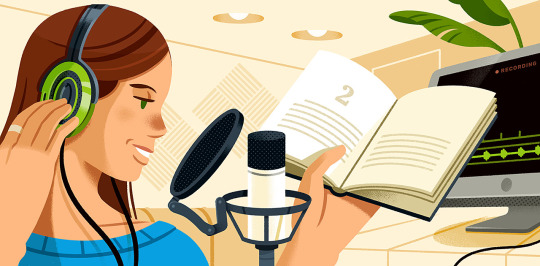
Some paragraphs have no action though. Think back to this paragraph:
Skittering! To the right! If it was a Fat-Roach, this night was gonna suck.
This doesn't mention any character at all. It looks like plain ol' narration. But we have a viewpoint character: Jeff. So any narration is more like "what Jeff sees," "what Jeff thinks," etc.
Jeff is acting here. What is he doing? He is thinking. This paragraph is narrating thoughts what Jeff thinks in this moment. So he is the character of this paragraph, kind of by default.
But then, how do we know Jeff is the viewpoint character, and not Arnold? The same way we know which character is the focus for a paragraph, but one level higher. They were the first one to act in our story. We started with "Jeff leaped into the air." So he became our viewpoint character—for this scene at least.
That's because I'm writing in "3rd person limited," where I'm limited to only what one character experiences and their internal thoughts—known as the "viewpoint character." If you're not writing with a viewpoint character, the reader will assume it's the narrator commenting on what's going on instead.

This is why when some stories start with a description of the kingdom or some backstory of the world, readers can feel a bit lost until a character is introduced. "Who cares about the lore if there aren't any characters in this story?"
And why it's more engaging to be introduced to a character doing something instead of just being mentioned as existing. "Okay, so there exists a princess in this world. But they're not doing anything, so this is just data. Skip to the story!"
Your mileage may vary on this. Tastes differ after all. But it's something to think about for your own stories.
In summary...
Paragraphs have 1 character doing 1 or more closely related things. (Even if those actions are no physical: observing, thinking, talking, etc.) This then condenses into a summary that will have some amount of impact on what happens in the rest of the story.
Sentences have 1 character doing 1 thing, possibly with added super duper closely related things of the same kind.
Though when I put it like that, it seems way over-simplified, and comes off as sentences being pretty much the same thing as paragraphs. And maybe chapters? And stories?
The advice "focus on the story being told" applies to all parts of the text, great or small.
And it's a fair guiding principle for writing good prose and good stories. But also not necessarily that helpful when you're "on the ground," and "in the trenches," writing the prose day-to-day.
That's because it's a lot more about intuition. About heuristics. About where it feels like you should end a paragraph, etc. Hopefully the intuition you've absorbed through these exercises will be a lot more useful than trying to enforce these "rules" for every piece of text in your story.
Perhaps you'll develop these ideas and have your own way of thinking about them. But hopefully this will give you a solid place to start from and you can get to ripping and stitching sentences and paragraphs whenever you want to! 🫶
#paragraph#sentence#splitting#breaks#writing#article#character#focus#dialogue#action#narration#thoughts#reading#active reading
5 notes
·
View notes
Note
Hey tapwrites I have a question in writing how could I write the unexplainable like something form a Lovecraftian horror stories I am thinking about to write an Lovecraftian horror story i don't know how to tell the readers how the unexplainable looking monster looks like. It really helps me if you answers my question and also have a good day 😊
Hey there... the important thing is the vibes.
In any writing, it's important to make it experiential, giving sensory detail. But also concrete descriptions so the reader knows what they're actually seeing.
With something like horror--particularly cosmic horror, and describing the indescribable--you'll have to lean more heavily on the experience of seeing it. The Lovecraftian madness and such.
I haven't read Lovecraft myself, but I'm guessing that's how he did it too. I'd recommend reading some of his work, and perhaps other cosmic horror to see how other writers have done it. Practise "active reading" to figure out what effect certain "descriptions" or lack thereof had on you as you read them. And what about the use of language gave you that effect.
Hope this helps :D
1 note
·
View note
Text
How to Start Writing Fiction
Many readers feel the urge to write at some point. But getting started can be daunting. Do I need to build a world for years like Tolkien did? Do I need write it all at once? What structure do I need to use? What do I need to do to write a successful novel?
When you're new to writing, the key first step is... throw all that stuff out the window!

Writing isn't publishing. Writing isn't success. Writing isn't making money. First you've got to be able to write without any of that. If you're lucky, maybe those things will come for you. But you cannot control those things. And so, there is no "way" to make them happen.
Your sole focus should be on what you can actually control--on writing as an activity...
In the early days, you may feel discouraged at not writing amazing stuff. But don't be so harsh on yourself. Think about your favourite book. Do you think it came out as amazing and perfect as it is when you read it? I can tell you for a fact it wasn't.
It came out with glaring flaws and huge issues and grammar problems and all the rest of it--just as yours will. They then spend months, even years polishing it, redrafting, revising, editing, using feedback... to turn it into something that looks like it just "came out that way" effortlessly.

Think of what you first write as a first draft, not the final version you'd see on the shelves for the world to see. When you start writing a new story, your job is to throw down messy blobs of clay--simply getting raw material on the table so you can work with it. Later you'll shape it into something pleasing to the eye... something that looks like it just fell out of the sky fully formed, painted, and glazed into its beautiful final form.
You don't know how to shape it yet. You will, over time. But for now...
All your focus should be on throwing down messy clay.
And by that, I mean, get used to writing new stuff. You don't need it to be good, you don't need it to be the next hit, you don't need it to be long. You don't even need others to see it! You just need to be able to write words.
Writing short pieces or short stories is a great thing to aim for at the start. Nothing fancy. That way when you want to improve later down the line, you'll at least be able to write something new to try out what you've learned. You could even make a new draft of something old you wrote with your new understanding.
But then... even knowing how to begin that stage can be daunting. How do people write? It varies.
Every writer has their own process, their own methods, their own style. There are generally considered two extreme ends to the method of writing:

Discovery writers make stuff up as they write the story. If you don't yet know what your preference is, I'd recommend starting here.
Just sit down, put pen to paper, and write what pops into your head. Find out what comes next as you write it.
Note, you don't have to put literal pen to literal paper. But "pen-or-pencil-to-paper, or finger-to-key, or voice-to-dictation-software" isn't nearly so pithy. However you like to record words, record them! XD Don't worry about what medium to use, what equipment, what software... use whatever is easiest to get out of the way and get on with writing!
A good way of getting started with this is an exercise: Freewriting Exercise to Stretch the Writing Muscles This gives you a short challenge that forces you to stop worrying about what comes next and if it's good and how to publish it and stuff like that... put all those aside, and get into the flow! Just start writing!
Give it a good try at least. Even if you don't turn out to be a discovery writer, being able to get into the flow of writing is still going to be a valuable skill as you progress.
And you may come up with new ideas for full stories, and start on those!
If you're finding you lock up in the face of the infinite possibilities of making-it-up-as-you-go... you may want to try a little outlining.

Outline writers make stuff up before they write the story.
So... they still sit down, they still put pen to paper, and they still write what pops into their head. But they don't do it in prose form. They do it in outline form. Then they turn their outline into prose form later.
This might be bullet points of important plot beats. It may include summaries of various characters and world elements.
I'd recommend just dipping your toe in before going full-bore into being an outliner. Somewhere else, just write a short line for something that will happen in the scene after the one you're writing. Or a short line about what happens at the end. You don't need to stick to that plan. It's simply a little pointer to give you just enough direction to not feel lost while writing.
Outlining can be a lot of fun by itself though! You can spend hours, days... years noodling with worldbuilding and moving plot points around, and never actually writing any of the story at all!
The problem is, it can be too fun. You can feel productive while actually spinning your wheels in worldbuilding-land. Getting stuck like this is referred to as (thunder sound effect) "WORLDBUILDER'S DISEASE!!!" (evil laugh)
Remember that writing isn't worldbuilding. Writing isn't outlining. Those can be part of your process. But...
A writer is a storyteller
You can do all the worldbuilding and outlining you want to and still be unable to write that story, because you have no practise writing.
So please, please, practise writing. Whether you're an ouliner or a discovery-writer, you still need to actually write to get started as a writer.
It can even happen that you have great fun outlining a story, but when you try to sit down and put pen to paper all that drive and fun has left you.
You may think, "How could I do such a grand vision justice?" Or, "Writing the story just isn't as fun as inventing the world and what happens!" "Am I destined to only make up worlds and outline things but never write a real story?"

These are telltale signs your brain enjoys discovering new things the most. That's probably what made outlining and worldbuilding so fun! But it also means that when you come to writing the story itself, you're no longer discovering anything, no longer imagining new things on a blank map of possibility...
Now you're following a very narrow route you've set for yourself and feel like you can't put a foot out of place because it's so carefully constructed that it could ruin everything if you do!
If you recognise that feeling, back off from outlining. You're probably a discovery writer. Sure, you can just worldbuild and outline for fun. Nothing wrong with that if you enjoy it. If your goal is to write stories, however, you've got to dial in that balance of planning and improvising that your brain likes.
This is why every writer has their own way of writing. Their own routines, their own process... it's whatever method their brain likes that also lets them get a story down.
So this is how to get started writing. To write stories. To figure out how you like to write.

When you've got past that point, and you're comfortably writing new stories... still try to hold off from wanting to become the next hit author and write the next epic fantasy or 5-book series. You can get to those if you want to, later down the line.
To even get published in the first place, you'll need to not just be a writer, but a good writer. So next, focus on becoming a good writer.
A good writer isn't publishing. A good writer isn't success. A good writer isn't making money. Those things do not define who is a good writer and who is not.
A good writer crafts the experience of the reader
You can only do that if you a) know what experience you want the reader to have, and b) know how to use language to shape the reader's experience into what you want it to be.
How can you do that? It's actually fairly simple. I have another article about the different things you should be doing to reach this next step: How to Become a Better Writer
So start your writing journey today, and I'll hopefully see you over there soon :D
10 notes
·
View notes
Text
How to Become a Better Writer
It can be easy to stagnate in your writing. To feel like you're spinning your wheels and not progressing.

"But I'm listening to all the writing podcasts all the time!" Unfortunately, it's not as simple as that. Writing podcasts are great (I highly recommend Writing Excuses)... but are best for passively absorbing ideas around the art of writing.
You cannot passively become a better writer.
So what should you do?...
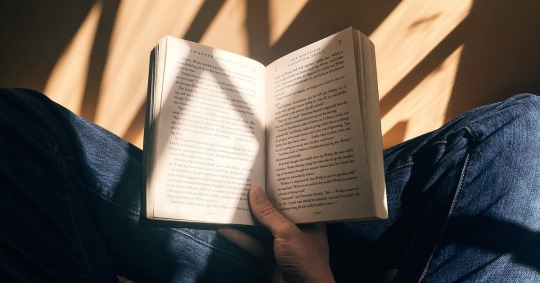
There are 3 main things to really get going in your writing: reading, writing, and getting feedback. (And there's a bonus hidden power up at the end!)
Reading
Read the language and medium you want to write in--regularly. ("Medium" being prose vs poetry vs academic papers, etc.) Why is that?
You need to learn and get a feel for how the grammar of the language works. You can do that with textbooks or a tutor. But if you've got a gut feel for what prose "looks" like on the page, because you've done a load of reading, you'll have a gut feel when your prose doesn't "look" right.
For example, if you've read a lot of dialogue, your brain naturally picks up on the rule that if the dialogue would end in a full-stop (period) but is followed by a dialogue tag... a comma is used instead of that period. And you won't have needed to memorise that edge case rule.
Reading lets you immerse yourself in the form of it, and absorb how it functions along the way. Including all the subtleties of how prose works that is different to everyday speech or communication. And it gives you a great baseline to learn these intricacies more directly, because it can click into place with what you've already picked up through reading.
Consuming stories through any art form--film, comic books, audio podcasts, etc.--helps you figure out your own tastes, your likes/dislikes when it comes to what you enjoy in a story. Which will form your style of writing, as you gain experience.
So reading isn't really required. For some, reading is a lot more difficult than watching a TV show, or writing their own stories. So you can learn these things in other ways as I mentioned.
The reason reading is the go-to recommendation is it is simply the most direct route. You can develop taste, understand story, and pick up on grammar and how the language works... all at the same time!
Whatever route you take, this is particularly helpful in the early days of writing. Seeing books by established authors with the eyes of a writer is a different experience to that of a regular reader. Instead of thinking, "Okay, I understood that part." You think, "Wow, you can do that in a novel?!"
You pick up tricks you can use in your own writing, as you read. And pick up on things you don't like in the way they write. This is "active reading"...
Don't just read: think about how what you are reading actually works on your brain.
You might think about how you would have written that sentence, or how you would've had it played out slightly differently to better hit that dramatic sweet spot.
That's what developing your own style is like, also known as a writer's "voice." Developing taste is when you start to gravitate towards some movies over others, and enjoy reading about certain characters and plots over others. You naturally do this when you've watched a lot of shows and movies. And you'll naturally do the same as you read books, as a writer.
Simply noticing what you like and dislike about what you read leaves you with a better sense of what you want your stories to be like. Both in terms of taste (genre, plot type, kinds of character) and style/voice (how you use the language to tell a story).

Writing
Writing regularly gets you the practise you need. Get used to sitting down and writing words--paper, digital, doesn't matter. And it doesn't matter if it's good. You don't need to show anyone else everything you write. What matters is that you practise the art of writing.
In the past I've used this exercise to get into the habit of writing, without worrying about it being good, editing/polishing it up, showing other people, etc. which actually lets the words come a lot easier. You can get into the flow of writing a lot better if you're not second guessing yourself, and this exercise gives you no time for such an indulgence! [Freewriting Exercise]
This is great for setting up a "mode" within yourself in which you are only creative, and you never second-guess or edit or revise. This is a great thing to work towards as you write, as it'll make the act of creating in the first place much more manageable. Think about it like this: when writing, your job is to slap down messy clay you can build with later.
Just writing something--anything--is productive in itself. And you'll probably start writing better stuff as you go just from the practise, and even find a story you want to develop from it!
But it's also good to finish things--both for the dopamine hit, and to be able to practise editing your work, understanding the structure of your story, and...

Getting feedback
Once you've got something you like but want to make better, get scientific! Ask people for feedback! (Preferably ask people that aren't your friends and family.)
Your goal in getting feedback is to understand how your writing is conveying your story to readers. What effect your use of language has on someone other than yourself.
Some will read it and like it, some will dislike like it, some may even hate it! Thing is, those are all subjective takes on what they read. When someone says a film "is good" or "is bad," they're really expressing that "it has things I like experiencing" or "it has things I don't like experiencing."
A hardcore fantasy fan might say a sci-fi film "is bad" because it doesn't have fantasy in it. Or visa-versa. All it speaks to is their personal tastes, not necessarily about the quality of the film as a whole.
Which means there's no need to worry. It's all just data.

Look at feedback like a scientist would the results of an experiment.
You're looking at your work in a scientific way. You're studying its effect on those readers. And through that analysis, learning how language affects their experience. Use that new understanding to bend language to your will so that it has the effect you wanted for your story.
This means it's not about doing what the readers want you to. Even if they're writers, and you respect their work... they are one reader among many. When it's published, it could be one reader among millions!
Others may have the opposite suggestion on the same piece. You could get 20 differing points of view. Don't give any one comment more weight than any other comment you might receive.
Learn about language and story, through reactions to your writing.
Use their reactions and suggestions to learn about language and story. Don't learn "how to make your story better," even if that's what they're trying to force on you.
Always, always, do what you want to do with your story. If you learn from the feedback and critique, and you end up wanting to tell your story differently, then do what you want and change your story. If you don't end up wanting to tell your story differently, do what you want and don't change your story.
In other words, any feedback can be taken or discarded at your own discretion. You're not trying to find out if your story "is good" or "is bad."
You're on a data-gathering expedition!
This process is vital to growing past writing readable prose and gaining mastery over the language--bending the words to your will and crafting experiences for readers to have.
By looking at things more scientifically, you'll begin to grow faster and faster. There's still a lot of subjectivity to it, of course. But that's the art: shaping another person's subjective experience by words on a page!
And as you do this more and more, you'll be able to write to a better standard even before you've gotten feedback.
"But it feels scary to share my work!"
It does, at first. "What if they don't like it? What if I get criticism?" The context of this process is that you are conducting experiments to gather data, sure. But it can be hard for your brain to get on board with that, and to skip the gut reaction of "oh no they don't like me!"
So here's one extra specific experiment you can conduct if you're worried about people seeing your work--even sharing complete stories we're proud of.
Write something you know isn't the best. Or is actually bad. First-drafts tend to be bad without editing--that's all just part of the process. So just write a little something. This is safe enough; if you lack confidence in the first place, then thinking your writing isn't good is par for the course, even if it's good. So doing this on purpose shouldn't be a big deal.
Now, knowing it's bad, post it somewhere actually requesting feedback on it. Asking people to tell you what's bad about it. You already know there's stuff wrong with it, things you might want to fix already. All that's happening is others are talking about the same things, and perhaps finding other aspects you can improve you didn't spot. That's the whole point of getting feedback: finding things that you'd want to fix that you didn't notice on your own!
But this way, you're initiating all of it, from writing "badly" to people telling you what you wrote "badly." That's what you wanted to happen.
And, even when you're more confident in your writing ability... that's what you'll be using feedback for too. This is like a practise run to get used to the feeling of putting something out there and people talking about what's good and bad about it.

Now, the uber-writers know this one last secret to growing as a writer: Giving Feedback (shh, don't tell anyone).
Giving Feedback
This is the juiciest of them all! You're active-reading... plus plus! Because you also have to put into words what is happening, which is even harder than just sensing you're not into how that writer did that one thing. You also get scientific with it--but from the other side!
That sentence didn't feel right to you. Why? How might it be changed to make it feel less weird? And how do you convey that to the writer so it's useful feedback?
That scene wasn't as impactful as you thought it was going to be. What about the structure of the story let that down? How might you shuffle things around to bring out the drama in that moment?
This is great practise for keeping your editor-brain separate to your writing-brain. You're practising not creatively writing at all, while being in the very analytical mode of finding any problems. You're figuring out how to shape the messy clay into something more purposeful, easier to read, more effective. While being detached entirely from the text, because it's not even something you wrote! This mindset is very useful when you want to get into editor mode and work on your own stories.
This kind of deeper thinking is what you get by giving feedback to people asking for it. And those that are looking for feedback are from all sorts of backgrounds, and all sorts of skill levels when it comes to writing.
You can see a lot of new ideas, new ways of writing, new traps to fall into, and analyse them all to figure out what makes them tick. And they tend to not be entire novels, so you can get a lot of that in a shorter time, too!
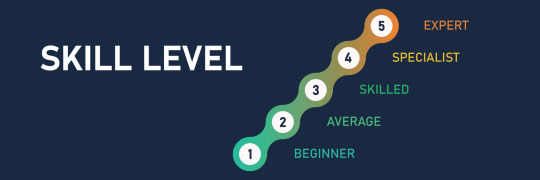
Just keep in mind those different skill levels when writing your feedback, however. Back when you were just starting out, if someone who seems to know what they were talking about said to you "it's good," like a family member might do... how would that have made you feel? On top of the world! And if they told you "it's bad," you would've quit writing on the spot!
So many writers have quit writing from bad feedback at an early stage for years!
This isn't to say you should coddle them and pat them on the head and send them on their way. Even if you sense that they're not at the "scientific" stage yet, they are seeking to grow as a writer. And hey, look at that--you're a writer, and you can help them grow!
So, start with a positive thing about their piece. Even if that's "you've got a clear vision of your world!" when you as the reader aren't exactly sure you have a handle on what that world is even if it's vividly described.
Be truthful, but find something that they've got a glimmer of that will help them in their writing journey. In the early days, finishing anything is tough. Having an idea and writing it down is tough. Getting tense correct is tough. Because it's all new to you.
Having a clear vision of their world isn't something everyone has. Sometimes it's so far in the background that you feel like you and the characters are standing in a blank white room. So even if the only good thing is that they have the confidence to have a world and present it to the reader... hype them up on that!
And whatever little slice of being a writer they've got is a good place to grow from. Nurture it, even in a brief comment pointing it out. Make them feel good about it.

Then, based on what their skill level might be, give them something to reach for in what they write next.
I like to make that clear to such writers... in the early days, you shouldn't be editing and revising and redrafting the same 3 opening paragraphs over and over, you should be writing new stuff all the time! So...
Give them something to work on for next time.
...Or next chapter, or whatever. Like, "For your next story, think about how you might show the world from your character's perspective more. What do they notice? What do they think about the statue in the distance? And how would they describe it? This helps the reader get to know the character better, just by how you narrate things. 👍"
Something simple, and understandable, with a hint of teaching them why that might be good for a story. Don't inundate them with your many pearls of wisdom and a full line-edit. Just gently help them take one more step in the right direction.
All of this is scaled according to the apparent skill level of the writer you're giving critique to, of course. A better-written story might warrant a real review of the story as a whole, and a longer list of aspects they could look into improving. Things like that.
Just be careful not to make people run away from writing. It's all too easy to cause.
43 notes
·
View notes
Text
How to Write Thoughts
Thoughts are pretty common to show in fiction, just as with dialogue. It shows not only what the character is thinking, but how they think about the world, who they are as people, their likes and dislikes... And so it's a vital tool to be able to whip out when needed.

There are a few ways of doing this though, and which you choose can depend on your own preferences and what perspective you are writing in.
Let's explore the rules of thought, and different ways you can deliver thoughts to the reader...
The thoughts the reader can "see" depends on the narrator, and the narrator's "perspective." An omniscient narrator sort of hovers above everything. They see all, they know all. And they hear the thoughts in any character's head they focus on.
Which means the narrator can say things like:
Hot dog time! Suzanne thought, almost hopping on the spot. While across the table Pete thought, Can't we get anything other than hot dogs? For once?
Where as a narrator with a limited perspective is stuck to a viewpoint character. They only see what that character sees, or hears, or experiences in that moment. And they can only hear that character's thoughts.
For example, first-person narration is always limited (probably?), so the narrator can say things like:
'Why am I here?' Pete thought, as he eyed his hot dog suspiciously. He looked across the table at Suzanne, chomping down her tubular-pork-in-a-bun. 'What is she thinking?'

Notice that there are different ways the characters' thoughts are being shown, though? Depending on the perspective, it can be important to indicate which parts of the text are direct thoughts plucked from the character's head--as opposed to narration or dialogue.
Single quotes can be used to mark a thought:
'Why am I here?' Pete thought.
A little more common is to use italics for the same purpose:
Hotdooooooogs! Suzanne thought.
These follow the same rules as dialogue, regarding punctuation, dialogue tags (or "thought tags"?), and knowing who is thinking through context. So I'd highly recommend reading up on that if you get a chance: How to Write Dialogue.
But you should pick one formatting style--italics or single-quotes--and stick with it for the whole story. Once the reader learns that single-quotes mean thoughts, then any change to that will get confusing.

When the perspective is limited to a single viewpoint character, you can use the same technique. However, there is another way of showing thoughts to the reader. I call this technique "narrated thoughts"--though you may have a different name for it.
Pete put the half-gnawed hot dog on the plate and pushed it away. He couldn't eat another bite.
How does the narrator know that Pete couldn't eat another bite? Because the narrator's perspective is limited to Pete's viewpoint. The narrator can hear what he's thinking, and tell us about it--even when not quoting the words Pete used.
If it were written another way, it could be:
I couldn't eat another bite, Pete thought.
A slight variation would be even simpler:
Suzanne scoffed down another bite, and washed it down with a gulp of coke. Frankie's always had the best hot dogs.
We know that because we're seeing everything from Suzanne's viewpoint that any opinions are her opinions, and any facts are facts she knows and believes to be true. The idea that "Frankie's always had the best hot dogs" is in there because she thinks that. And we did it without even mentioning the character in that sentence!

This style of thought can feel more natural to the reader. We aren't stopping the narration to present a thought we plucked out of the character's head. Everything is plucked out of the character's head; so there's no need to stop the narration at all. We can just keep on going.
Now, you can have narrated thoughts and direct thoughts in the same story. Though most of the time one dominates the other.
The cool thing about narrated thoughts is, you can just slip them into the narration and the reader won't even notice! They're not trying to piece together where each bit of info came from; they're just experiencing the story. As it should be.
6 notes
·
View notes
Text
Story is Continuity
While the story builds up in a person's mind, it builds the context for the rest of the narrative.
When a new piece of narrative doesn't fit with the story in the reader's mind, this takes them out of the narrative. Because now they've got to reconcile the two.

The most obvious cause of this would be errors in continuity. One chapter describes a character as being old, and the next describes them as being young. That doesn't fit with what the reader remembers, so they're confused. Did they misread, or misremember? Did they just make up something that wasn't there?
Now, this moment of incongruity and confusion can be intentional...
If the reader doesn't know that, the distrust will still happen... so it's best to indicate that "yes, I know this is confusing" by "hanging a lantern on it." Have a character react the way the reader is likely to—that way they'll feel okay with being confused, because they know you know it's confusing.
Another time you may intend this confusion to arise is in a mystery story. If the narrative brings up something the reader won't understand, they'll be wondering about how it all fits... until that question is answered. So if you set up something mysterious, you are promising the reader that it'll be demystified later in the narrative. If you want them to be thinking about that, then all good!
Sometimes a writer puts in something mysterious by accident, and doesn't want the reader to be focused on it. It's not the point of the narrative, and it won't be answered. So... best not to make that promise, by fixing it up so the mystery isn't planted in the reader's mind in the first place.
And that's the best case scenario from this confusion—that they're interested in what the answer might be. Alternatively, this can ruin a reader's immersion in the narrative, sow distrust of the writer, and may even cause them to give up! So take care when using this; show you know what you're doing, get them to trust you, and then start tugging at their emotions.

Pop-in can happen if something new is added that the reader didn't expect.
If in the middle of a scene a gun is picked up from the desk... if the gun was never mentioned in the scene's description, the reader may not have imagined it with such a detail. And so to them, they have an empty desk in their version of the story... and now a gun pops into existence on it. And then is immediately picked up.
Again, you can use this surprise to your advantage. If the character instead pulled a concealed weapon, it's meant to be unexpected. So the reader having this confused reaction at the sudden turn of events is exactly what you want.
Otherwise, if the gun was described earlier in the scene as being on the desk, the reader has that clear in their mind. So when the writer says a character "picks up the gun," the reader has no trouble following along. They just keep adding to their picture of the story being told.
By "setting the scene" and establishing this detail earlier, the writer can safely rely on that detail being in the reader's image of what's in the scene.

Ambiguity can also trip someone up when reading.
If a scene describes an outside setting, characters, and conversation... and then there's a tidbit of description about how the moonlight glistens in the trees... that could go one of two ways.
Did the reader happen to imagine the scene taking place at night? Then they'll probably breeze right over it.
Did they imagined a daytime scene? There's a decent chance they could have. So they saw the characters in the daylight the whole way through. When that one guy was seen walking home from work, they must've been a night-worker. It could colour all sorts of other aspects of the scene incorrectly... because the writer failed to specify the time of day.
And now when the reader finds out it's night-time, they have to reconcile that with the rest of the scene they've already been through. It was dark out, maybe people huddled by a fire, and the guy walking home works during the day. Only once they've got that sorted out can they continue taking in more of the scene.
Again, if the writer wants to rely on certain things that are obvious to the characters—for example, the time of day—those things must be made obvious to the reader, or the flow and immersion will be messed up.

On the other hand, good continuity can not only avoid confusion, but strengthen the narrative.
If a character walks through a rainstorm to get to work, and later in the scene puddles are described pooling about their desk... that detail came from the earlier detail. They link together. And together they feel more real to the reader.
If a squire's father was killed by an elf, and he happens upon an elf caught in a trap, on the edge of death... overcoming his hesitation and saving the elf's life has more impact. Because we know what it took for them to do it.
Now, for each of the following details... think about what difference that single aspect would make, if they came before this elf-saving moment:
The squire serves a lord who hates the elves even more than the squire does.
There's a war against the elves happening in the background of the story.
His older brother died in this war.
The more earlier details that elf-saving moment pings in the reader's mind, the more this moment in the story is strengthened.
When everything builds up to a single moment—often the ending of the story—that ending becomes more and more impactful for the reader.
The moments that balance the greatest number of plates have the deepest impression on those that witness it.
To my mind, the ideal story would culminate in a single word, the last of the whole story, which is the culmination of all words that came before it, and sets a whole new context through with to understand the story as a whole.
(Which doesn't really happen, but the closer you get to something like that, the bigger the hit to the reader when the reach the end of the narrative.)

There is a genre of writing called flash-fiction: stories with very few words, which push each word to do the most. Which means relying on the most continuity, as well as providing the most context for words that come after.
A classic example in this genre is just 6 words long:
For Sale: Baby shoes, never worn
Heavy stuff, right? And there's even a narrative here. But only 6 words to do it in.
Take a moment and look at it one word at a time. What does each add to the story so far? What previous story does it rely on? What context does it set up for later story?
There are also other aspects of #story to explore, if you want to continue the journey...
2 notes
·
View notes